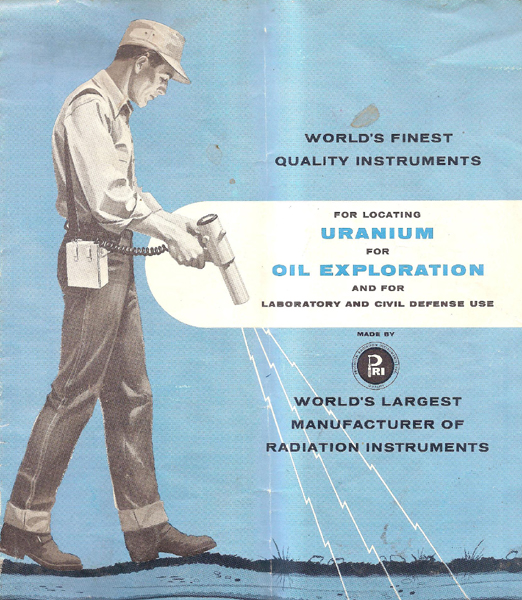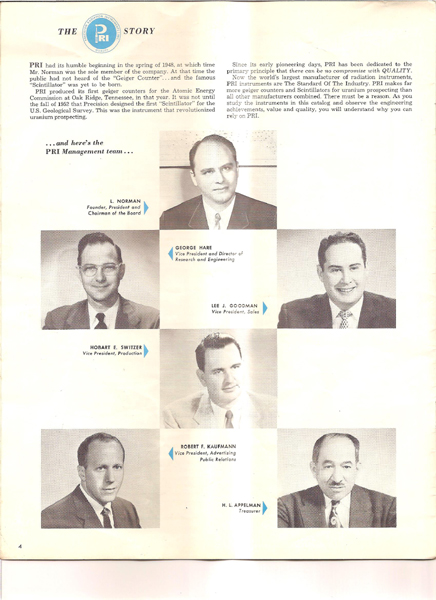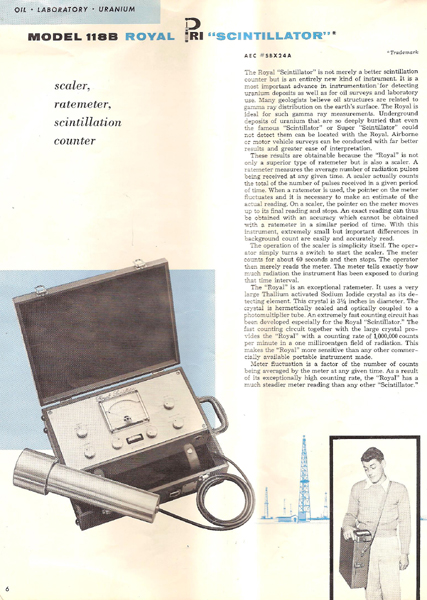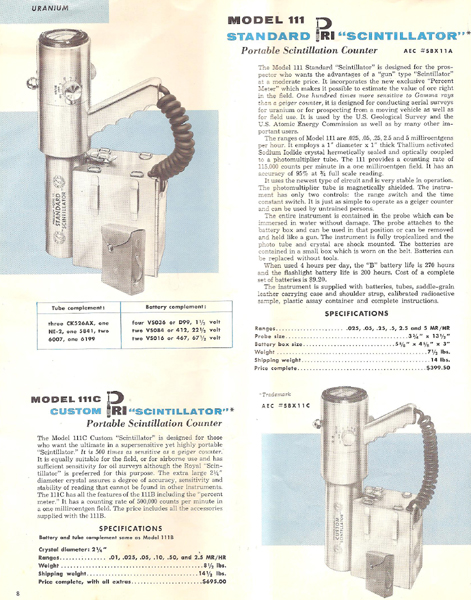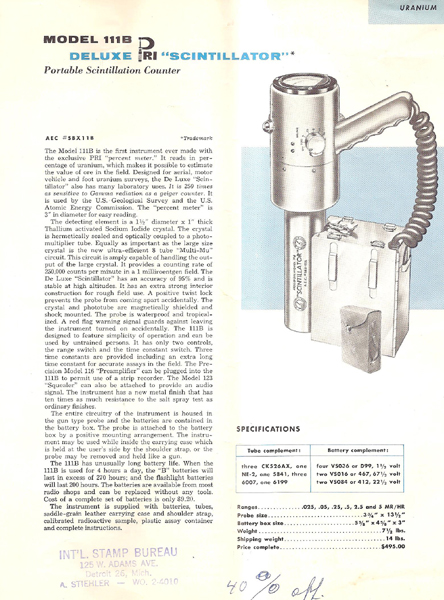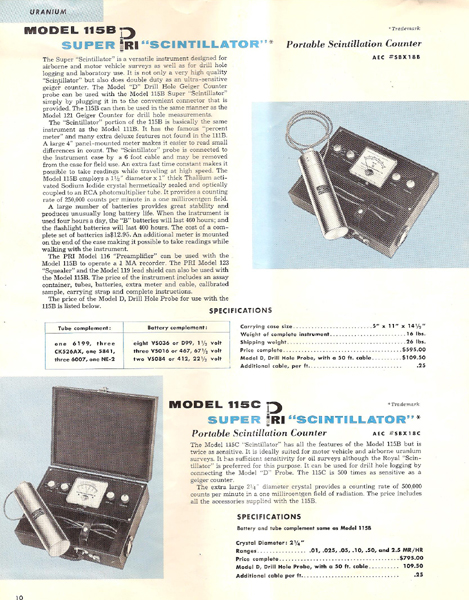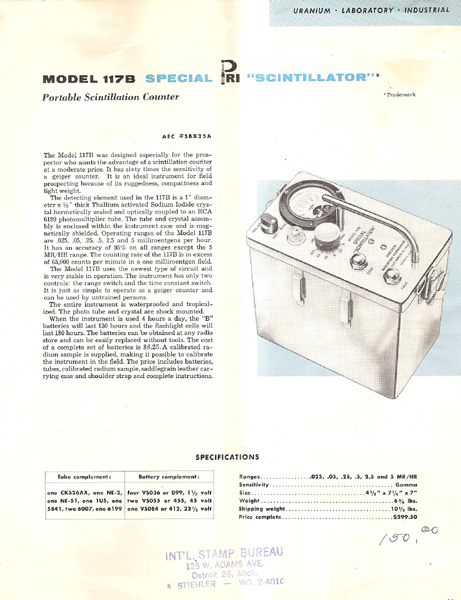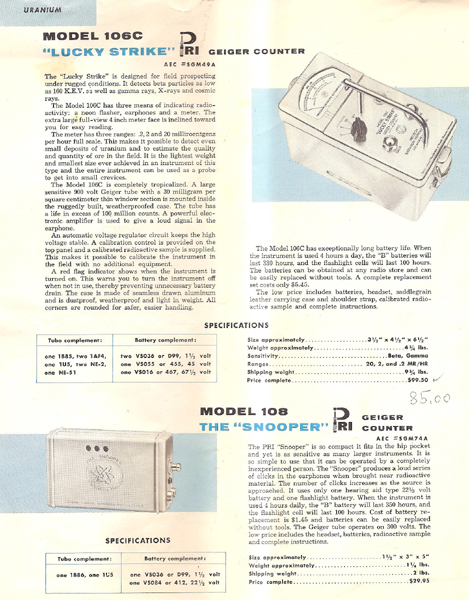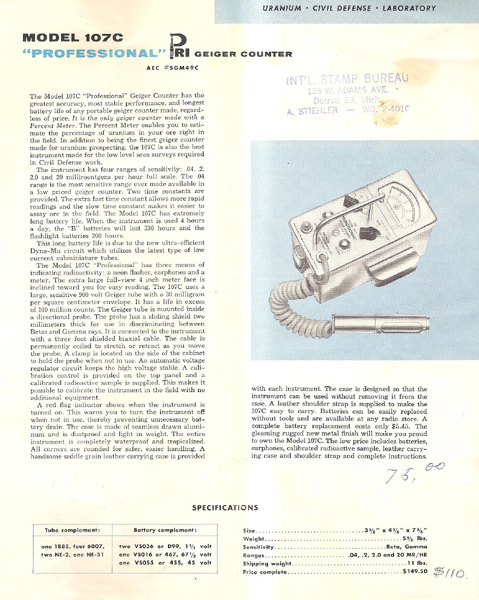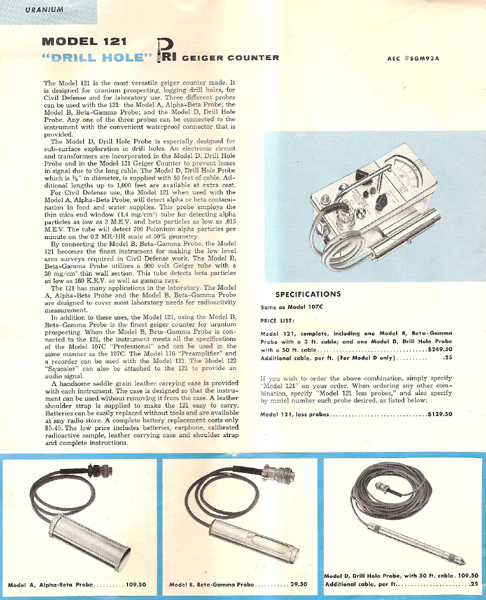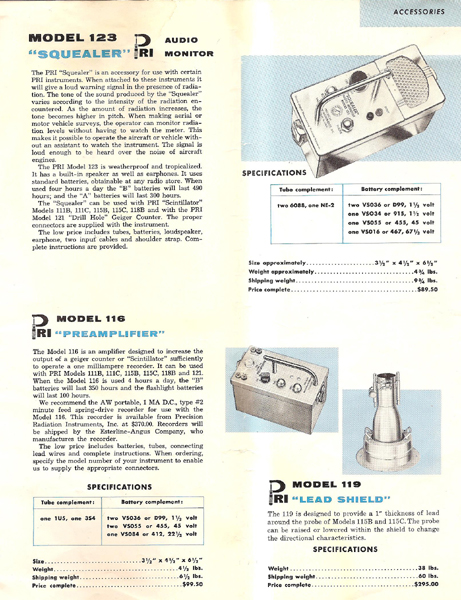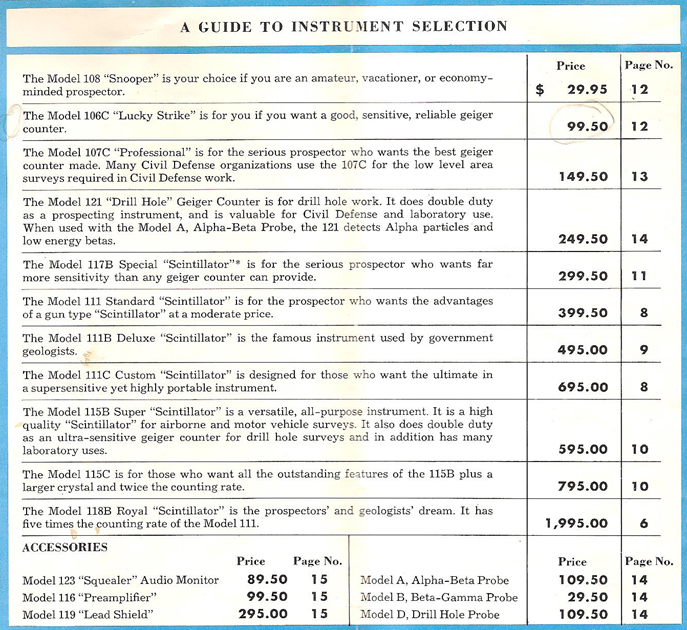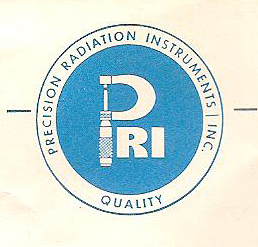
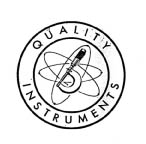
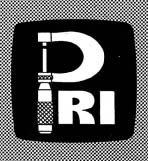
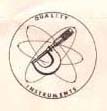
Precision Radiation Instruments
In 1948, Precision Radiation Instruments was located at 1101-L North Paulina Street, Chicago, Illinois. Later in the 1950’s, Precision Radiation Instruments (PRI) moved to 2235 S. La Brea Avenue and then to 5478 Wilshire Blvd in Los Angeles,. In 1955, they were located at 4223 W. Jefferson Blvd (1955) in Los Angeles, CA and began producing a line of Geiger counters for uranium exploration. It was advertised as the "World’s Largest Manufacturer of Portable Radiation Instruments".




PRI Logos 1955
In 1948, PRI introduced the Model 101, a new GM survey meter with true portability. It was advertised as “The Finest Portable Count Rate Meter Ever Developed”. It weighed under 7.25 lbs. and measured 5-3/8” x 6.5” x 4.5”. The unit also had a plug-in probe making replacement very simple even in the field. The probe was also lightweight, waterproof and had a rugged cable. The GM tube was filled with neon and ethyl ether. The probe can detect both beta and gamma rays. It had a long battery life and could be replaced without specialized tools. The unit sold for $239.50 in 1948.

Precision Radiation Instruments Model 101 1948
The PRI Model 101 was advertised as a completely new and different portable beta gamma GM discriminating count rate meter. It has a thin wall glass GM tube mounted in a stainless steel probe. It was lightweight, illustrated in the following ad showing lifting with one finger, and had a long battery life. All major components are on a revolutionary plug-in unit that allows for easy replacement. It weighed 7.25 lbs. Full scale reading was 0.2, 2 and 20 mR/h. It can detect betas as low as 160 keV and had a 2 mm thick beta slide. It used 1.5, 45 and 300 volt batteries. The probe was mounted on the top of the instrument and had a 36” cable. It had a waterproof phone jack.
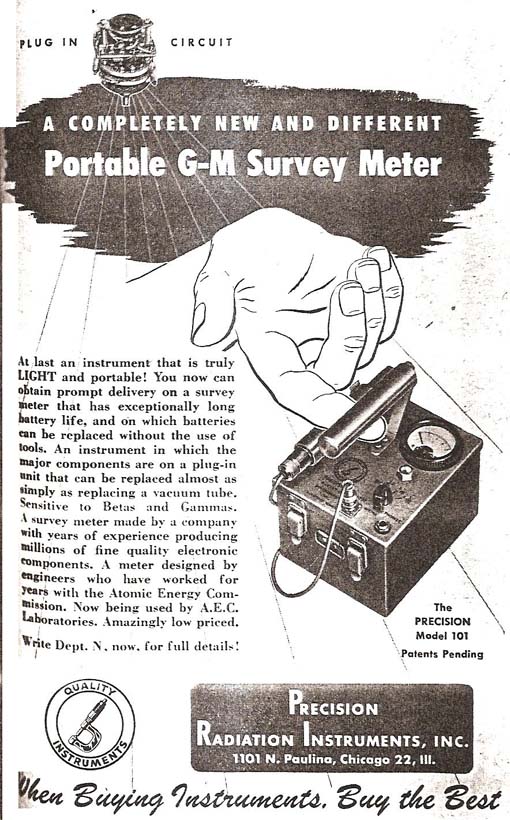
PRI Model 101 Ad 1948
The PRI Model 102 was introduced in 1949. It is a portable GM counter designed to measure low energy alpha, beta and gammas. This unit was an innovative approach to put the measurement of alpha, beta and gamma capability into one instrument. It has a detachable probe with Geiger counter and a thin mica end window. It could be used to detect beta-emitting C-14 and other radioactive tracers. It was advertised to be sensitive to 700 polonium alpha particles per minute. The end window also has a beta shield. Two MeV alphas and 0.025 MeV betas can be detected. The full scale reading is 0.2, 2 and 20 mR/h. The tube is self-quenching with a voltage threshold of 900 volts. The unit is 5-3/8” x 6.5” x 4.5” and weighs 7 lbs. It sold for $289.50 in 1951.

PRI Model 102 1949
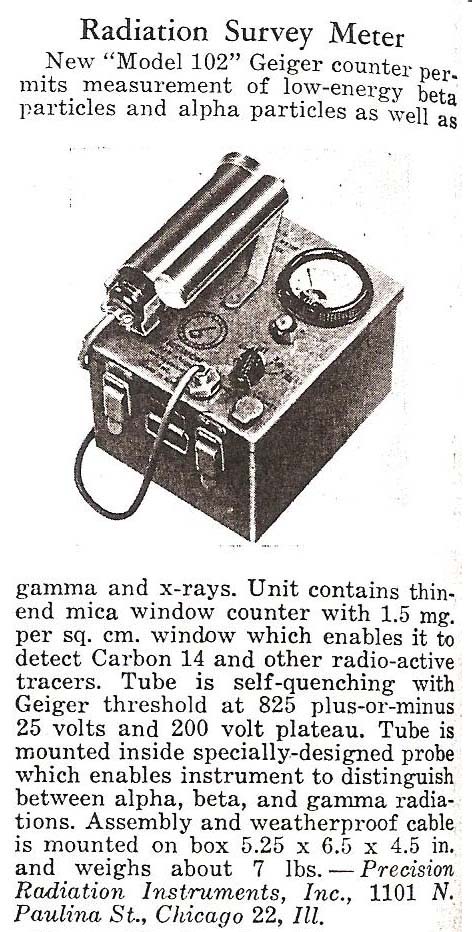
PRI Model 102 Ad 1949
The Model 103 is identical to the Model 102 with the exception of a directional capability. As noted by PRI, “The Geiger tube has a center wire which is divided into four different sections by three glass insulators, symmetrically placed. Radiation entering parallel to the center wire will cause discharges in the Geiger counter”. The geiger tube is the same except that it is enclosed in a lead shield 1 cm thick and weighs 5 lbs. The directionality from front to side is 25 to 1 and detects gamma radiation only. The unit has particular application in the detection of radioactive tracer isotopes in medical laboratories. The unit sold for $299.50 in 1951.
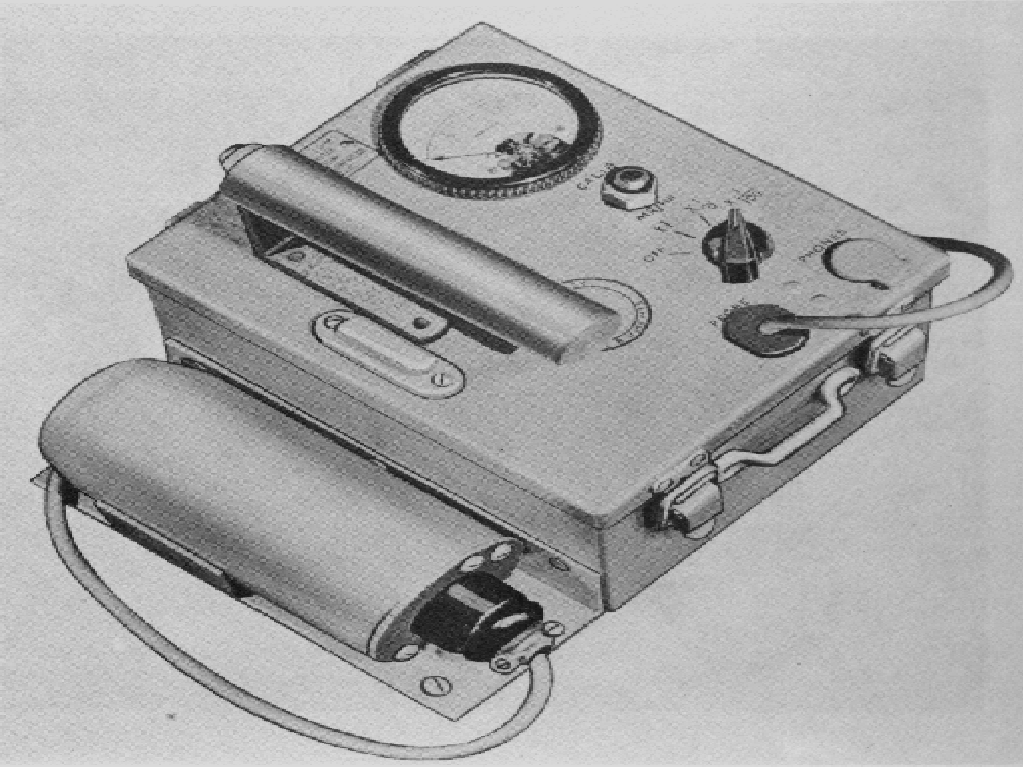
PRI Model 103 1949
The PRI Model 104 “Gamma” Geiger counter was introduced in 1949 prospecting. It was designed for the prospector who wants a low priced instrument. It was a field portable beta-gamma survey meter with headphones. The small, compact unit had the GM tube mounted internally to aid in ruggedability. It automatically turns on when the headphones are plugged in. It was designed for locating radioactive ores. It will give three times the number of clicks in the headphones from an ore containing 0.05% U3O8 than normal background. The unit weighs 2 lbs., has a low voltage Geiger counter, and uses a 300V battery. It has a charging circuit for actuating the headphones which is the only indicating means. The unit measures 3” x 4” x 5”. The unit costs $49.50 in 1951.
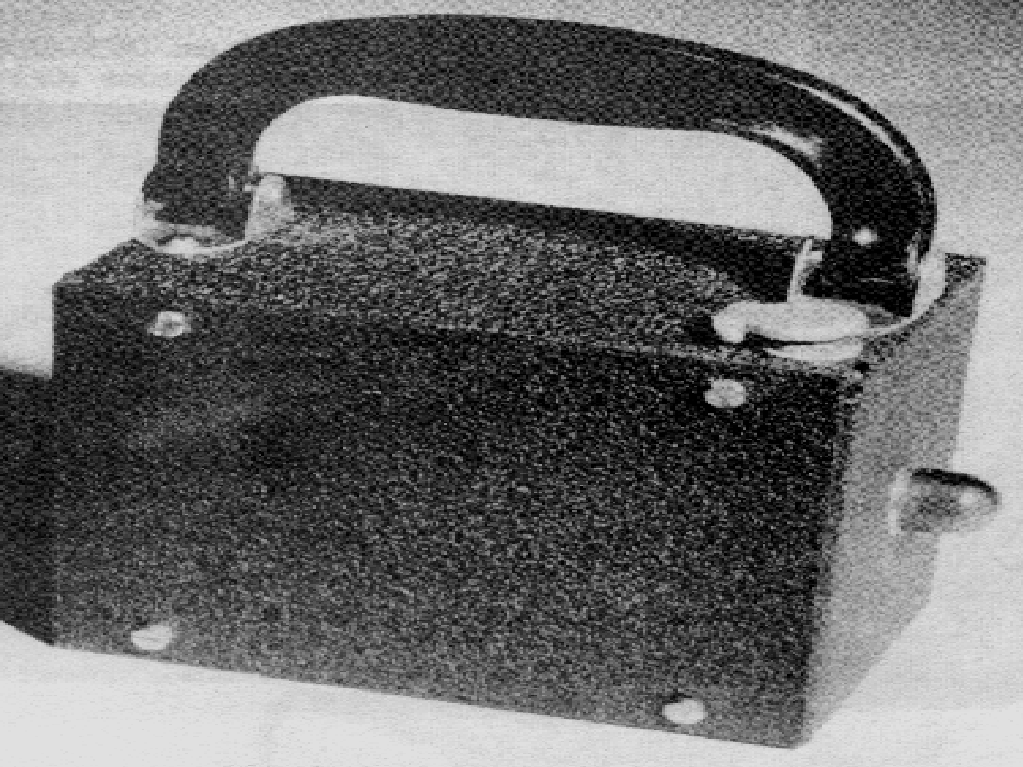
PRI Model 104 “Gamma” 1949
In 1949, the Model 105 “Prospector” was introduced as a smaller Geiger counter sensitive to both betas and gammas. The Geiger counter employed a 900 volt plug in tube with a thin window. The window provides detection of beta rays down to 160 keV. It was suitable for laboratory work with its audible alarms but was designed for field use in locating radioactive ores. It is easily carried or attached on the belt. It operates on a single 300 volt battery even though the GM operates at 900 V, advertised as “very nearly a case of getting something for nothing”. It measures 2.75” x 3.25” x 6” and weighs 2 lbs. The large GM tube is enclosed within the case. It employs only one battery that is good for one year with normal use. The life of the Geiger tube was advertised as more than one hundred million counts. It came with a crystal earphone and battery for $49.50.
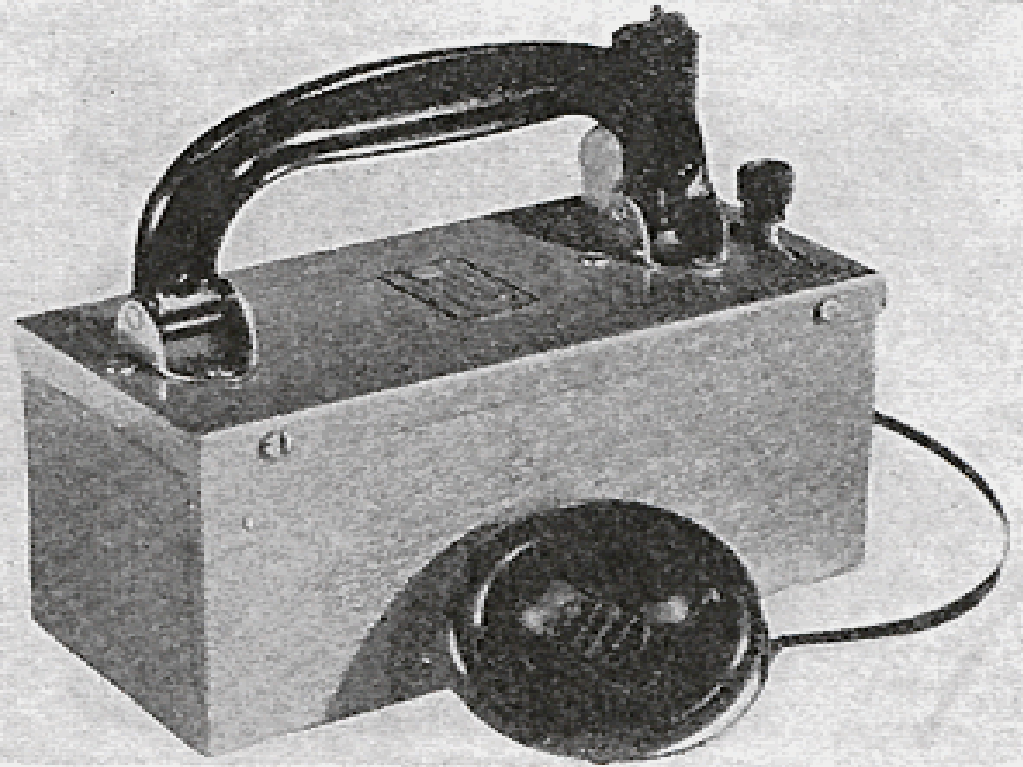
PRI Model 105 “Prospector” 1949

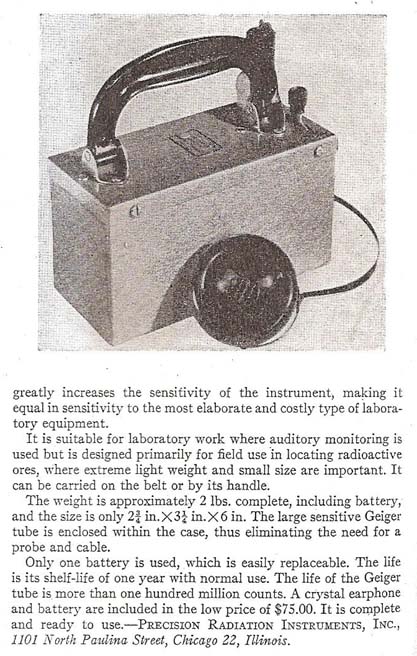
PRI Model 105 “Prospector” Ad 1949
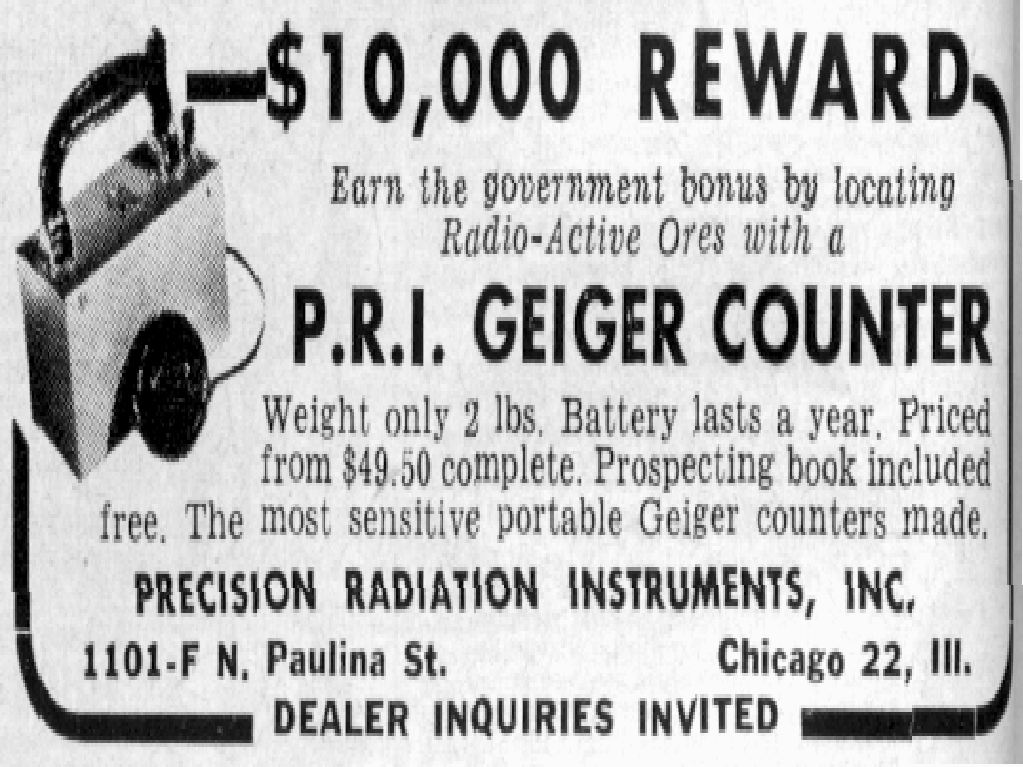
Popular Science Ad 1949
In 1955, PRI’s sales brochure stated that $2,000,000 in bonuses were paid by the Atomic Energy Commission for uranium finds. They were being awarded at a rate of $150,000 per month. The most famous of the prospectors was Charlie Steen, a 33 year old poor prospector who discovered a $40 million claim.
The “Lucky Strike” Model 106 was introduced in 1950 as a portable beta-gamma count rate meter for uranium prospecting. The unit is 3.5” x 4” x 6.5” and weighs 4 lbs. It included three ranges with sensitivity from 0.2-20 mR/h. It uses an internal 900V Geiger tube with a thin window section for beta detection down to 160 keV. The power supply uses two 1.5, two 45 and one 22.5 volt batteries. The output could be from the meter, neon flasher or headphones. It also has the option for an external stainless steel probe. As advertised, it has "only one simple control designed so that it cannot catch on the clothing and be turned on accidentally". The unit could be carried by the handle or attached to your belt. The unit sold for $99.50 in 1951.


PRI Model 106 1950
The Model 106B was offered for $99.50 in 1955.


PRI Lucky Strike 106B

PRI Model 106B and 107B Operation and Maintenance Manual 1955
The Model 106B, Lucky Strike, had a readout in mR/hr intensity ranging from 0-0.2. The Model 106C Lucky Strike sold for $99.50 in 1955.

PRI Model 106C 1955
The PRI Model 107 “Professional” was introduced in 1950 as a count rate meter for laboratory use and for locating radioactive ores. It met all Atomic Energy Commission Standards. It was a portable GM counter for civil defense. The sensitivity indicator had settings of 0.2, 2, and 20 mR/h. It has an external Geiger tube which is directional and housed in a stainless steel probe with sliding beta window. It uses two 45 and two 1.5 volt batteries. Also available is a mica end window tube for alpha detection as low as 2 MeV and betas as low as 0.015 MeV. It has a neon flasher, meter and headphones. It measured 3.5”x4”x6.5” and weighed 4.5 lbs. The unit sold for $139.50 in 1951.
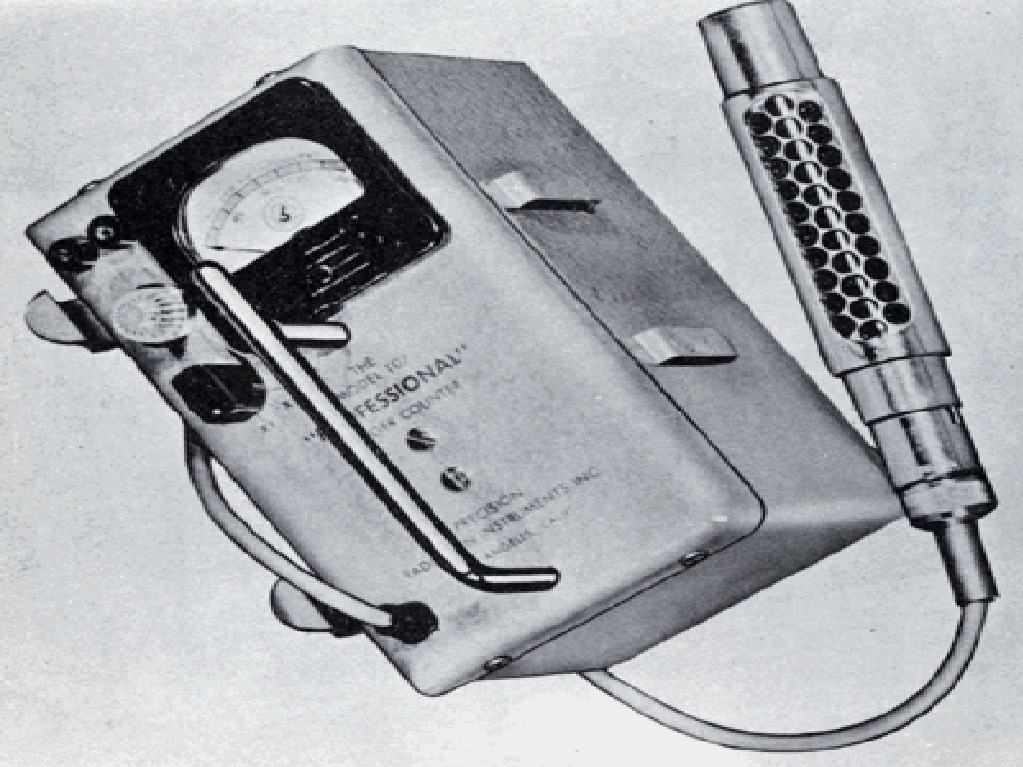
PRI Professional Model 107 1950
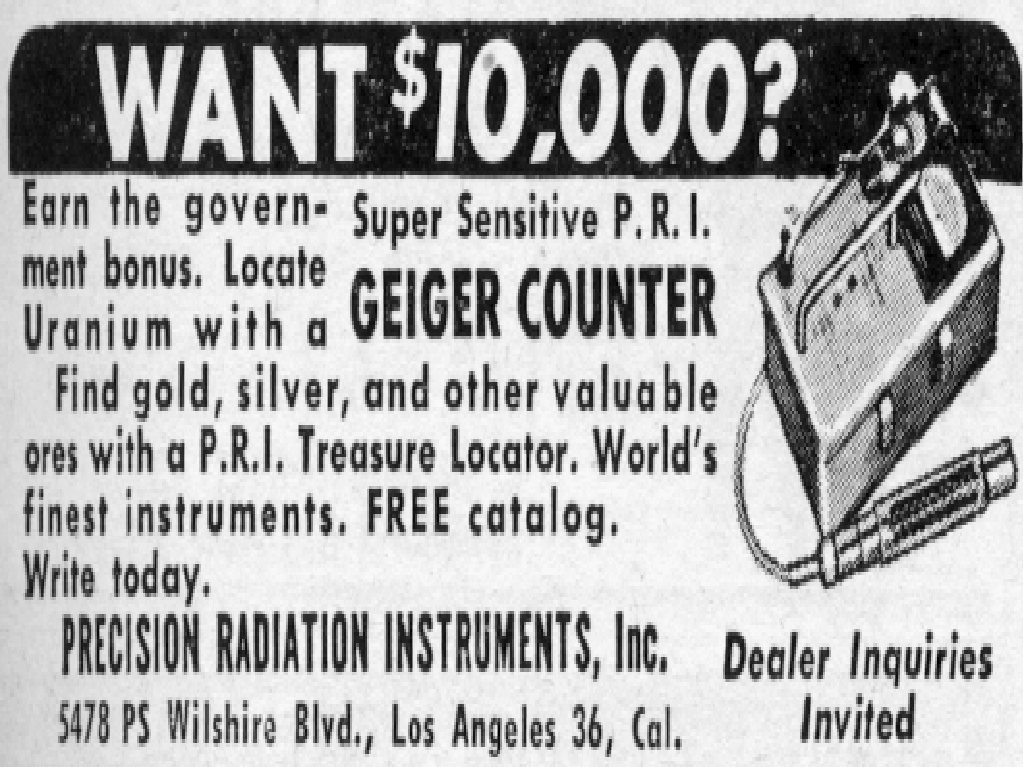
Popular Science Ad Model 107 1950
The Model 107B Professional was offered in 1954 as an upgrade to the Model 107. It could detect betas, gammas, x-rays and cosmic rays. The meter had three ranges of 0.2, 2 and 20 mR/h. It had a 900 volt Geiger tube. The probe had a shield for beta discrimination. The probe has a 3’ cable. It was designed for use with headphones. The unit was the choice of serious prospectors that did not want to invest in a higher sensitivity scintillator. It also met AEC standards. It used two flashlight, two small 45 and one 22.5 volt batteries. The unit was 3.5” x 4.5” x 6.5” ad weighed 6 lbs. The Model 107B sold for $139.50 in 1954.
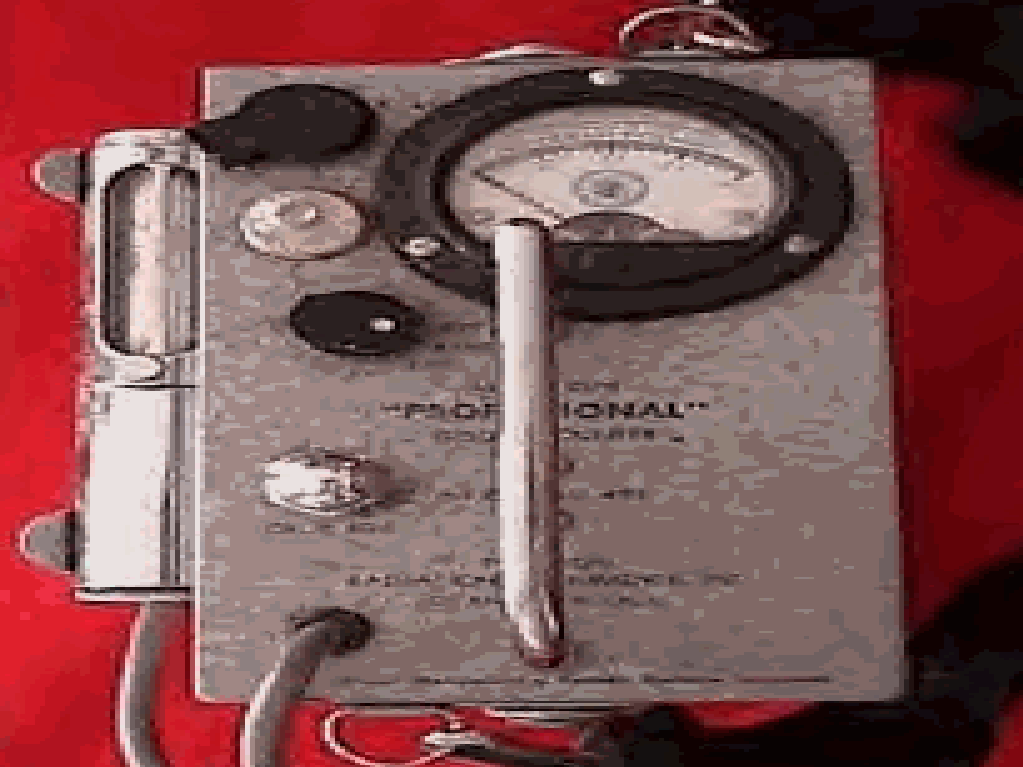
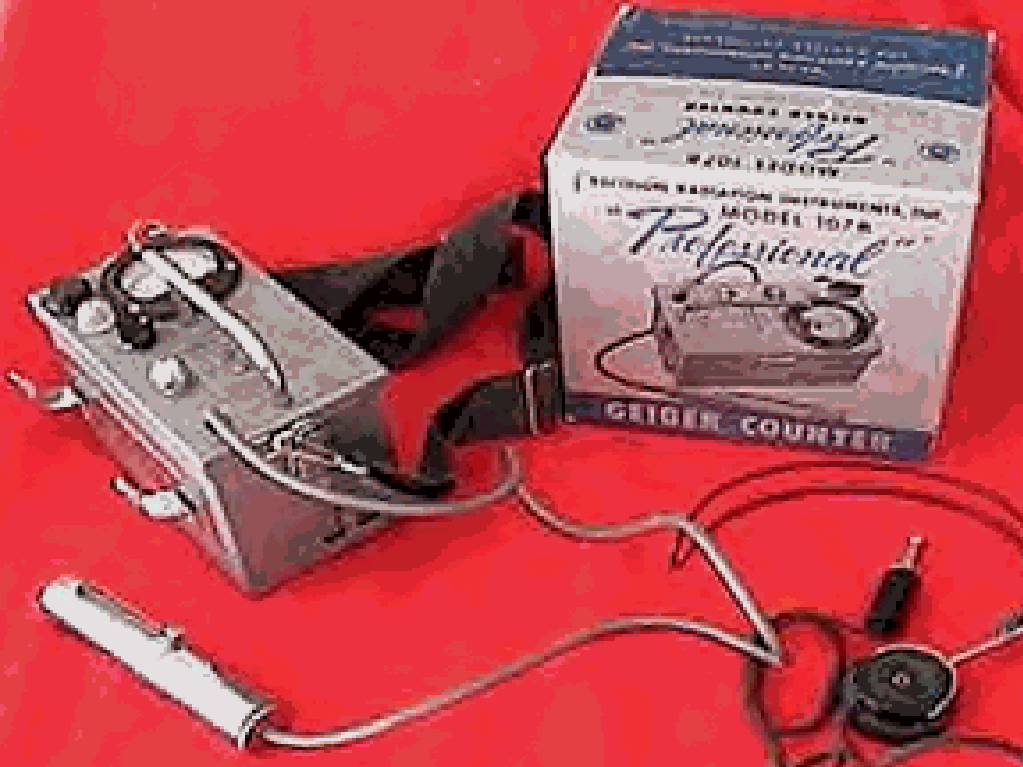
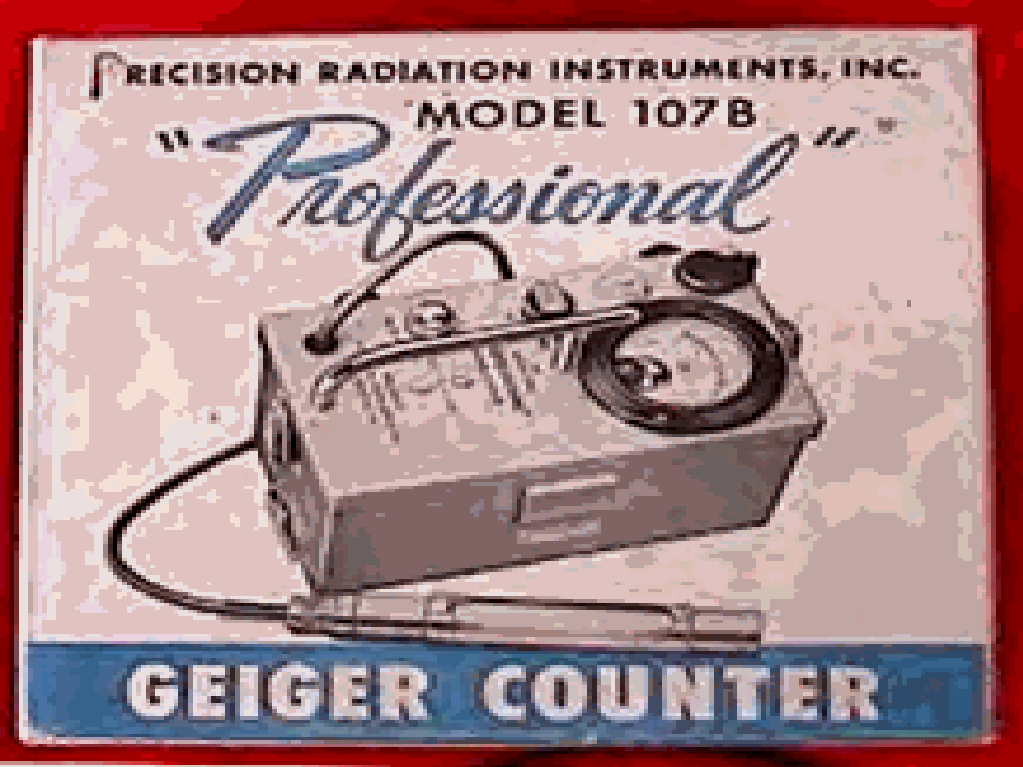
PRI Kit Model 107B Professional 1955
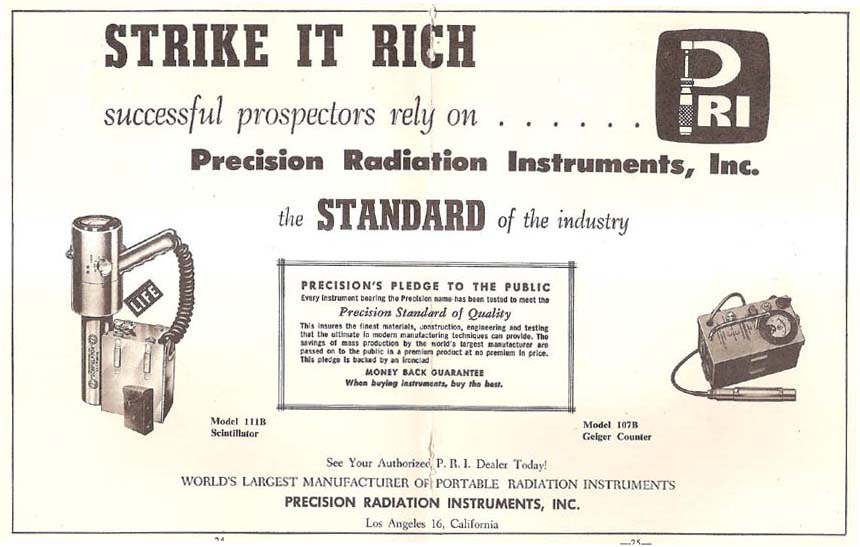
PRI Model 111B and Model 1707B Ad 1955
PRI Model 107C “Professional” Geiger Counter weighed about 6 lbs. The unit was advertised as “the first Geiger counter with a percent meter and enables you to estimate ore value right in the field”. It has four ranges from 0.02, 0.2, 2, and 20 mR/h. Radioactivity is indicated by a meter, a neon light and through and earphone. The unit detects beta and gamma radiation. The unit has a chrome finish. A thin walled, gas filled Geiger tube with dimensions 3/4" diameter and 4" long, is mounted in a waterproof probe. The probe has an internal GM tube and beta shield and attached by a three-foot cable. The shield is opened by turning a knurled head screw on the probe. Opening the shield allows the detection of both beta and gamma. Sensitivity range is the same as Model 106. The Model 107C sold for $149.50 in 1955. The counter comes with the original box, leather case and straps, original headphone, extra wand, and instruction manual. It used one 67.5 volt B battery, one 45 volt B battery and two flashlight D 1.5 volt batteries. The unit came with a calibrated radium disc mounted in a clip on the end of the case. The operators manual states that if you locate an ore with promise, "send at least a one-pound sample to the U.S. Geological Survey, Geochemistry and Petrology Branch, Bldg. 213, Naval Gun Factory, Washington, D.C. They will assay the sample without charge and give their report only to the individual submitting the sample. If their report indicates the ore has commercial value, it should be offered to the U.S. Atomic Energy Commission, 70 Columbus Avenue, New York 23, New York, Attention: Raw Materials Operations."
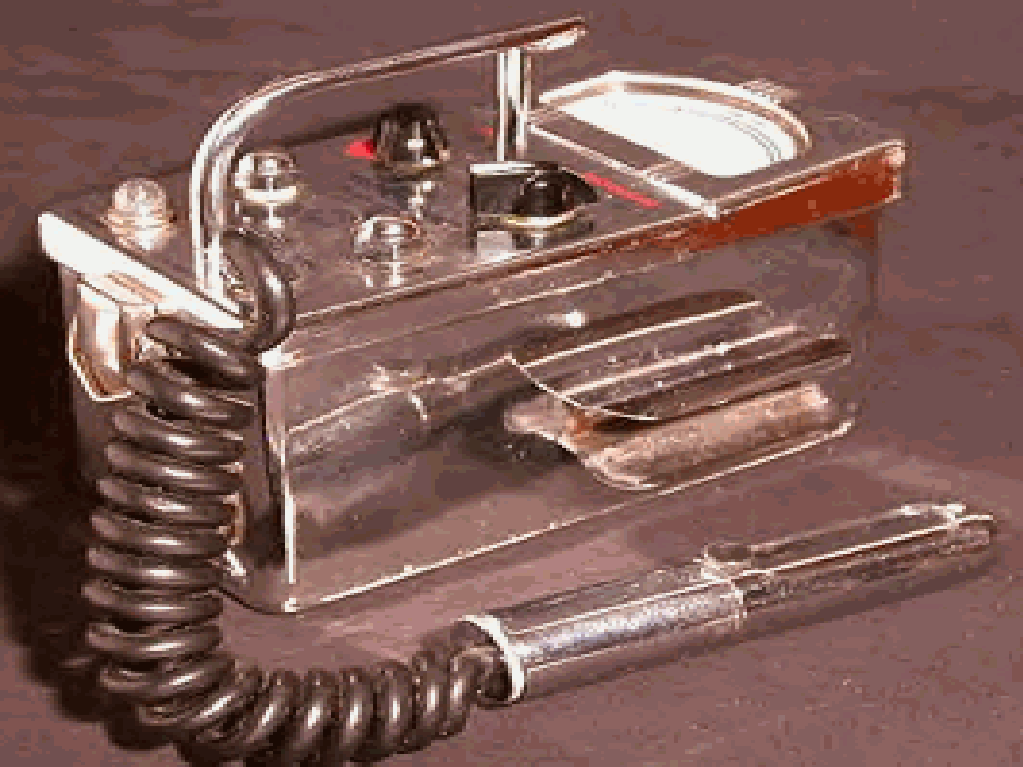
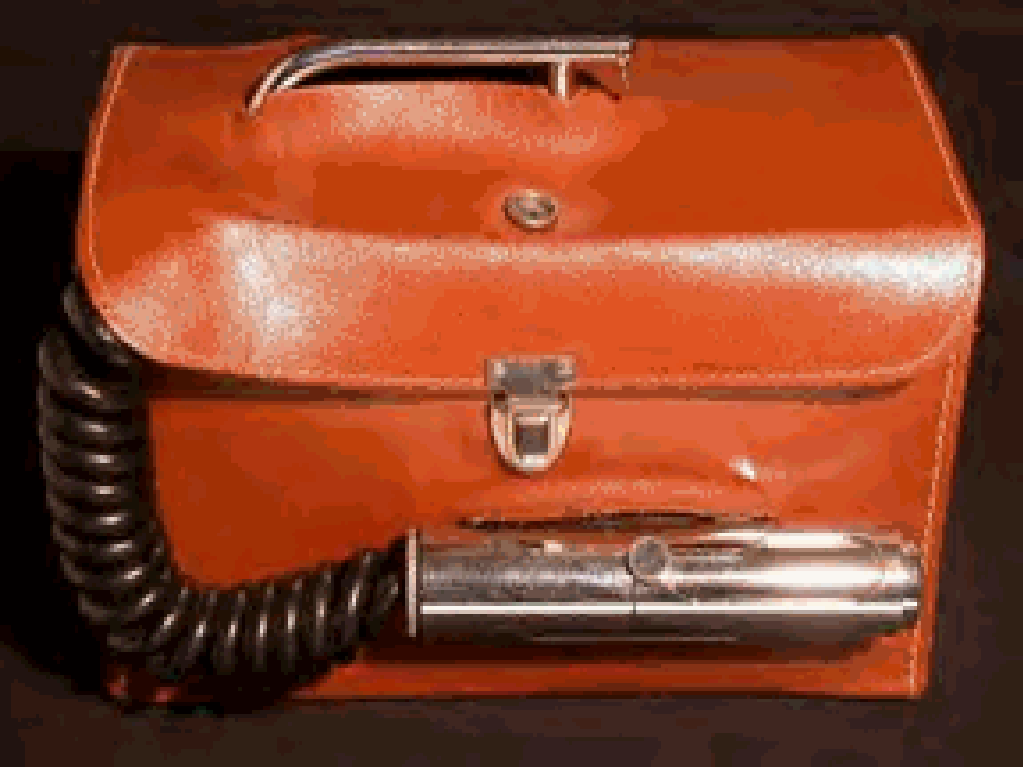
PRI Model 107C 1955
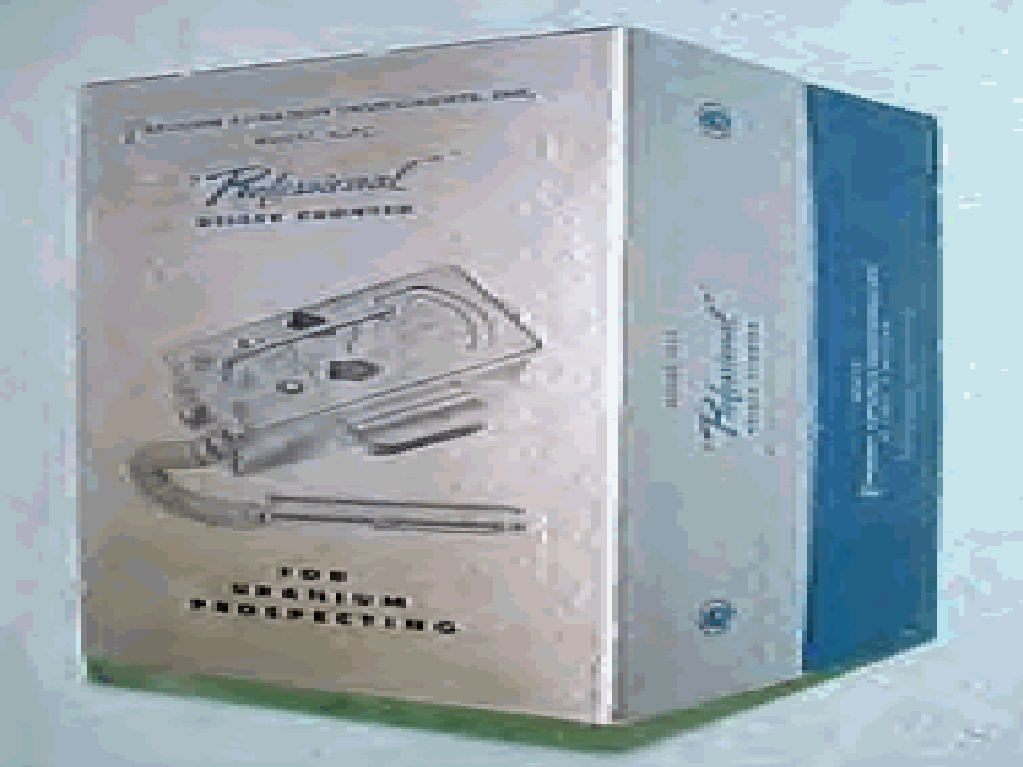
PRI Model 107C Box 1955
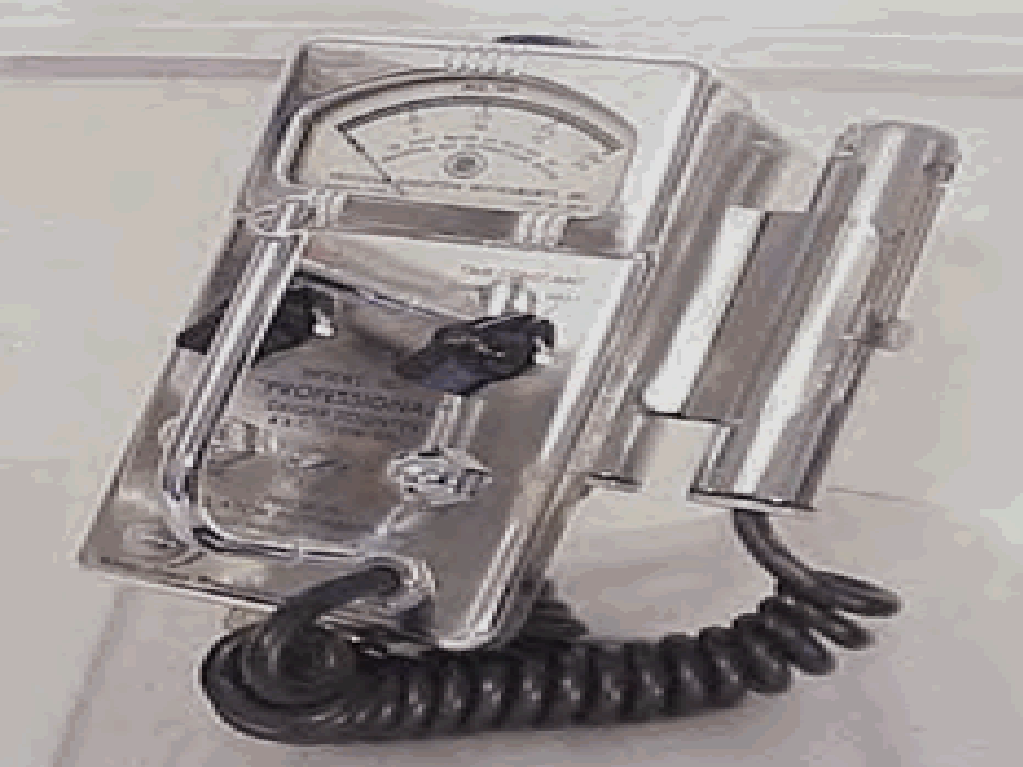
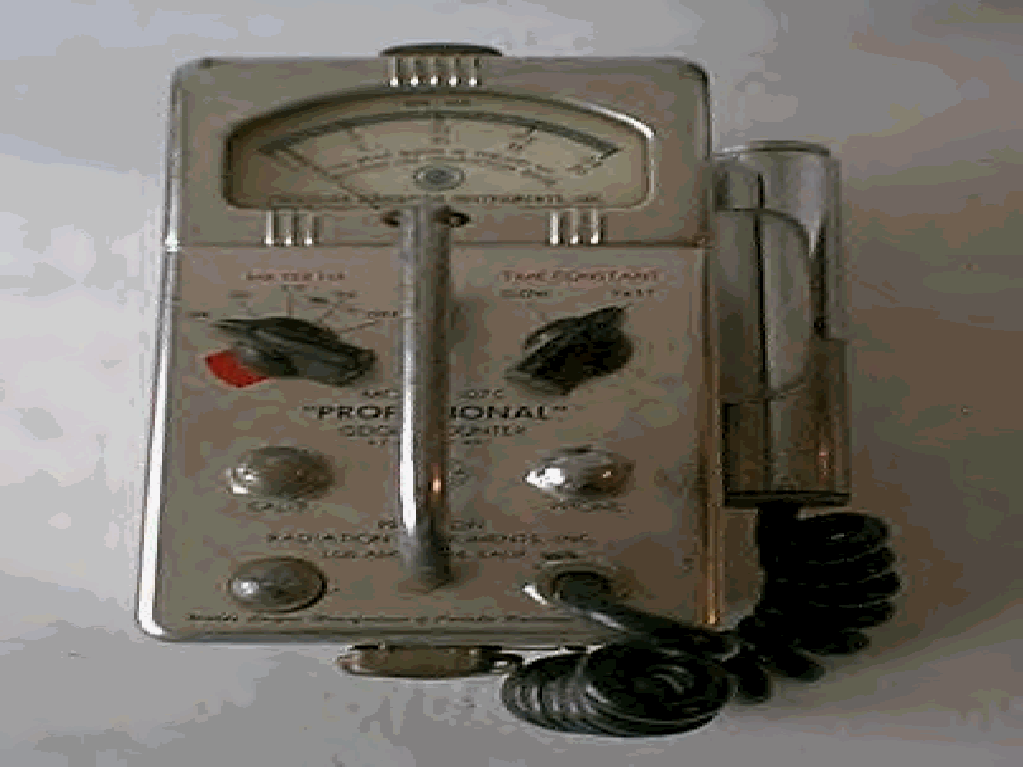
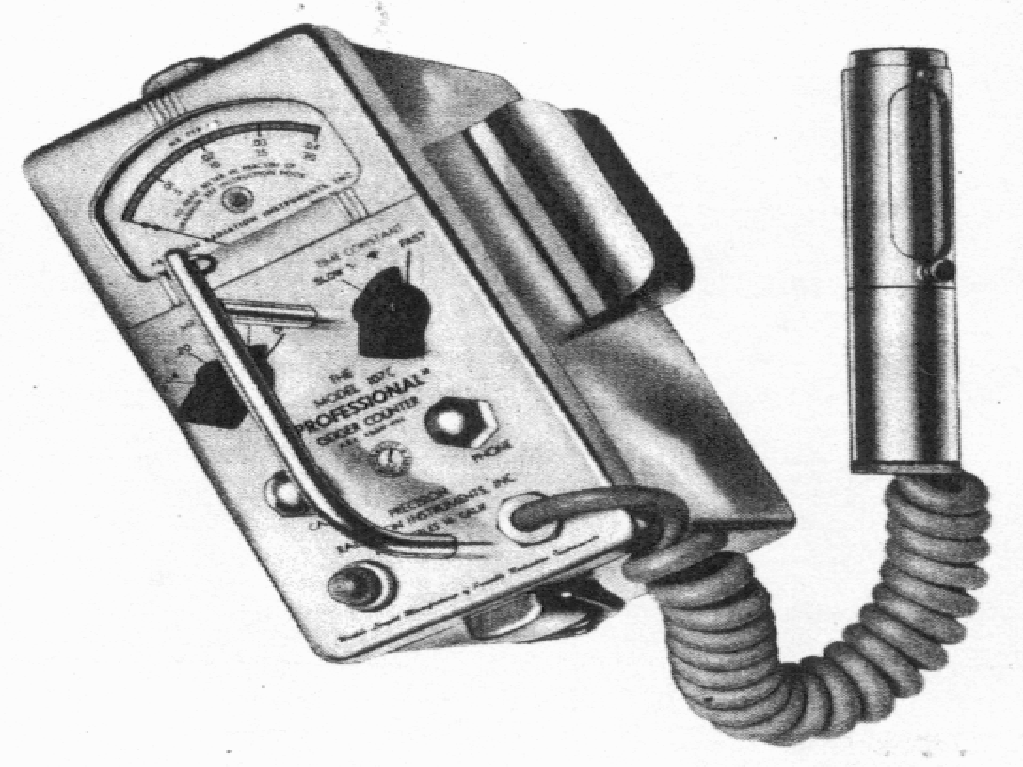
PRI Model 107C Chrome 1955
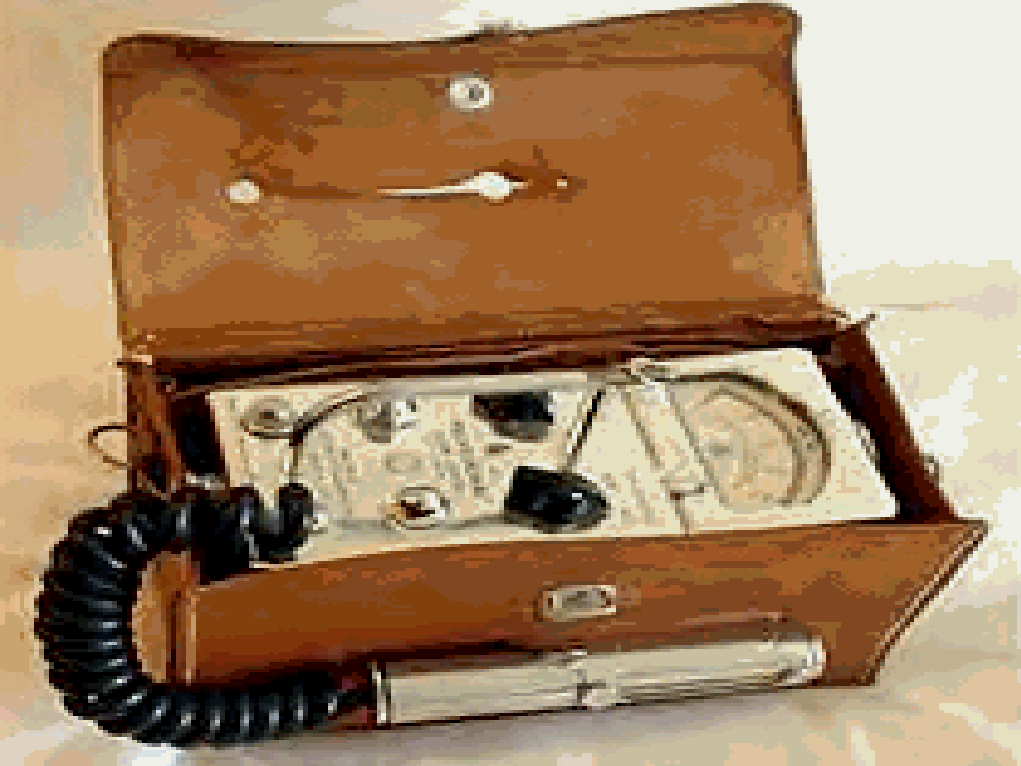

PRI Model 107C 1955
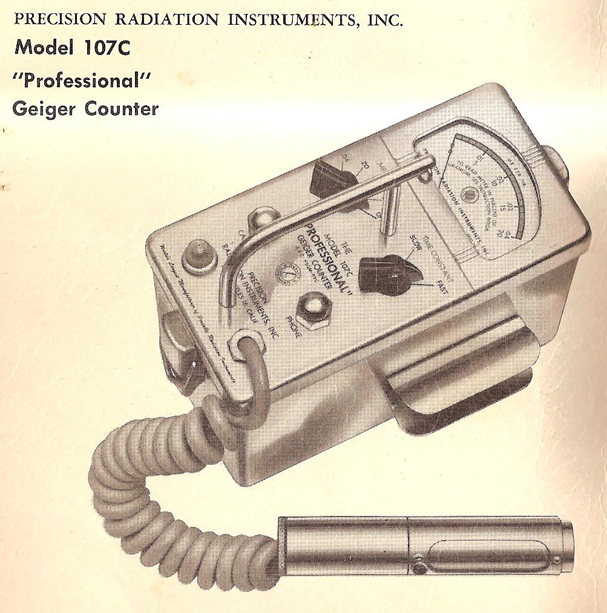
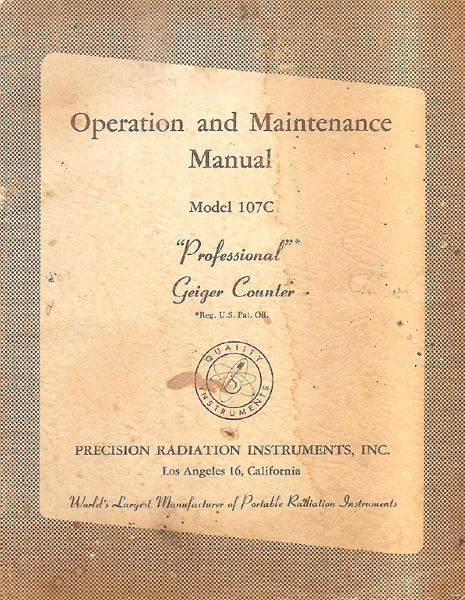
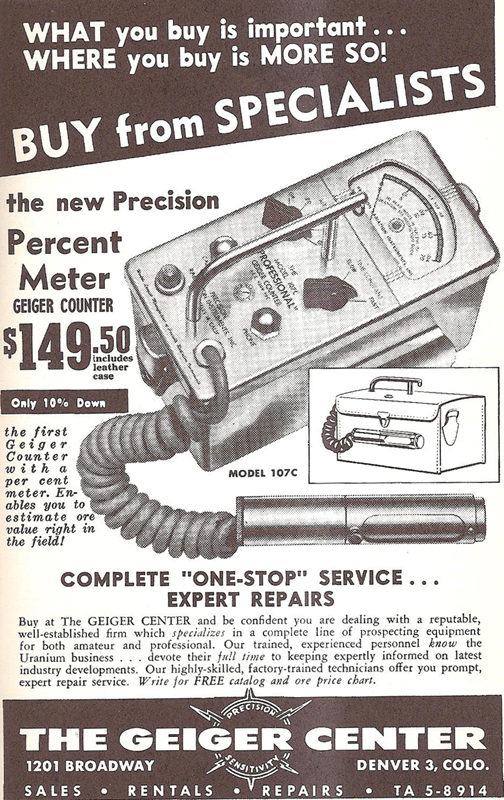
PRI Model 107C Ad 1955
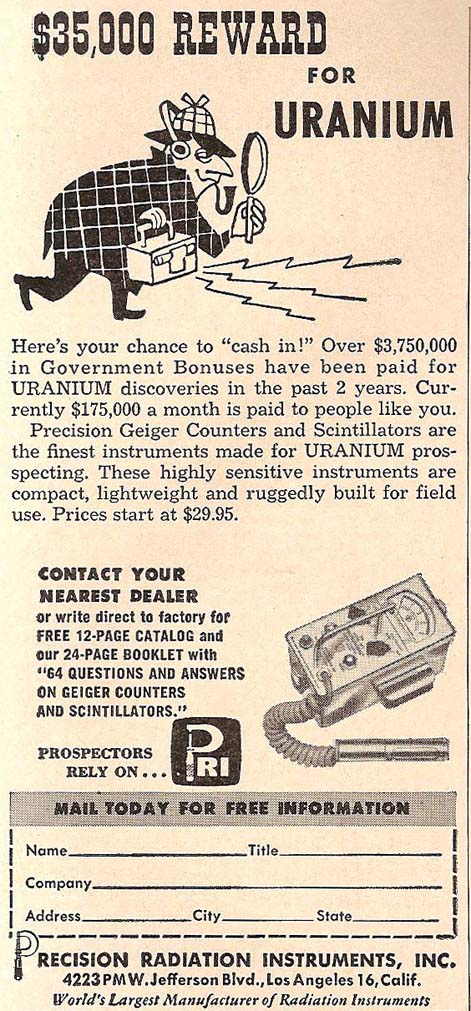
PRI Model 107C Ad 1955
The Model 108 “Snooper” was sold to opportunist for getting rich quick on uranium ore in 1951. The instrument was relatively cheap for the average user. The unit was compact 1.5” x 3” x 5”, weighed 1.25 lbs. and had a plastic case. The Geiger tube was operated at 300 volts from one 22.5V hearing aid and one flashlight battery. To operate the unit, turn it on and press the button 3-4 times until clicks are heard. This charges the Geiger tube for operation. As the clicks get weaker, push the button 1-2 times to recharge the tube. Normal click rate is 30-50 per minute. The manual said “a fair amount of radiation will cause the clicks to be as rapid as the firing of a machine gun”. There are three holes in the case near the Geiger counter for testing samples. Battery life was advertised as 6-12 months. The headphones were used to listen to clicks provided by the unit. It is about 1/3 as sensitive as the Lucky Strike. The unit could be traded in on more advanced models.

PRI Snooper Mod 108 1951
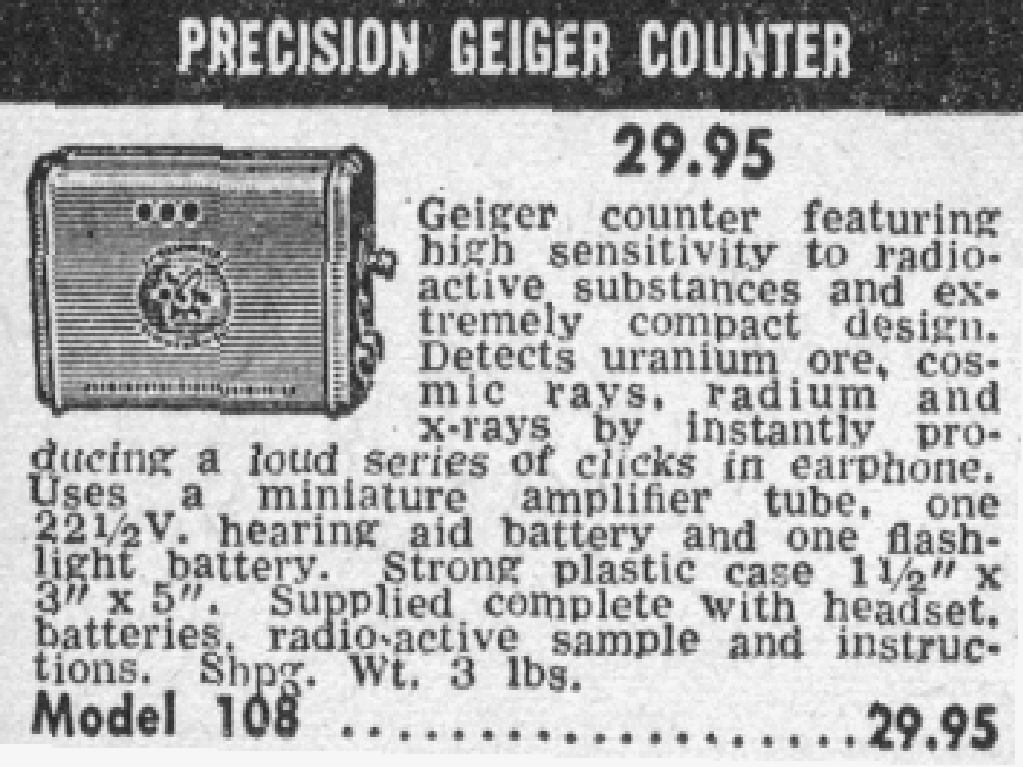
PRI Model 108 Ad 1955
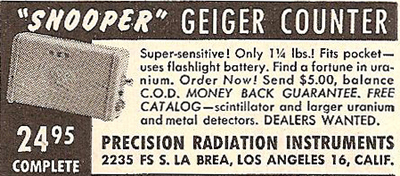
PRI Model 108 Snooper Ad 1955
It was advertised that if you find a high radiation source, send a one pound rock to the U.S.Geological Survey's Geochemistry and Petrology Branch in Washington, DC. They will assay it for free and return the results to you. If the report shows a possible commercial find, it should be offered to the AEC, Raw Materials Operations, in New York, NY.

PRI Snooper Model 108 1955
The Model 109 was introduced in 1952 and was similar to the Model 107 except that it employed an end window GM tube. The unit could be monitored by meter, flasher or headphones. It could detect alpha contamination of food and water supplies. It had scales from 0.2, 2 and 20 mR/h. It used two 1.5V, one 22.5V and two 45V batteries. It weighed 7 lbs and sold for $199.50 in 1954.
Need photo
PRI Model 109 1952
The Model 110 has the same features as the Model 107 and Model 109 and marketed for Civil Defense use. It sold for $249.50 in 1955.
Need photo
PRI Model 110 1955
PRI offered a series of five “Scintillators” in 1954 for uranium prospecting.
In 1952, PRI introduced the Model 111 Standard “Scintillator” Cutie Pie. The pistol grip type is for uranium prospecting by hand or car borne. The detector was a 1” x 1” sodium iodide crystal. It was 100 times as sensitive as a Geiger counter. It was suitable for aerial surveys or surveys from moving vehicles. It uses a circuit designed by PRI for the US Government. The photomultiplier tube is magnetically shielded. It has two controls and a long battery life. It used four 1.5-volt flashlight cells, two 22.5 and two 67.5 volt batteries. It was waterproof and tropicalized. The ranges were 0.025, 0.05, 0.25, 1, 5, and 25 mR/h. The battery box is 3” x 4.5” x 5.25” and weighs 4 lbs. The probe is 3” x 13.5” and weighs 2 lbs. The counting rate in a 1 mR/h field is 115,000 counts per minute. The battery box can be attached to the belt with an extension cord to the pistol type counter. It sold for $495 in 1953.
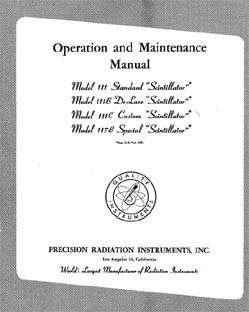
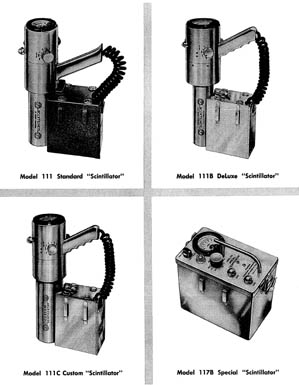
PRI Model 111, 111B, 111C and 117B Scintillator Manual 1950's

PRI Model 111 Scintillator 1954
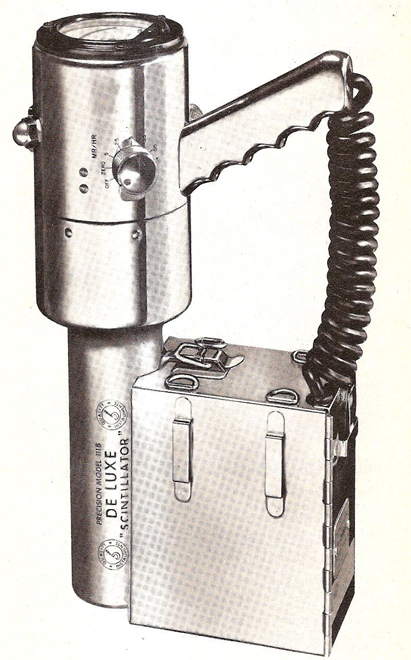
PRI Model 111 1950's
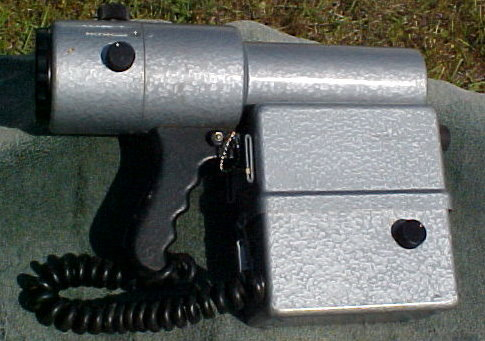
PRI Model 111 Scintillator 1950's
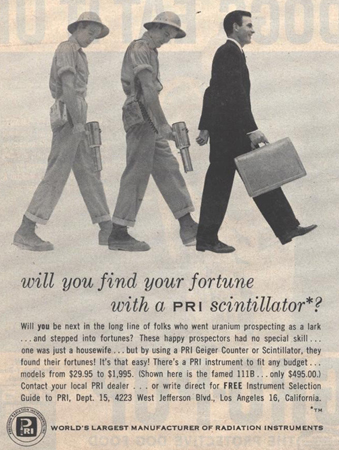
PRI Ad 1950's
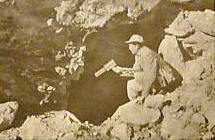


PRI Model 111 Photographs from Ad 1950's
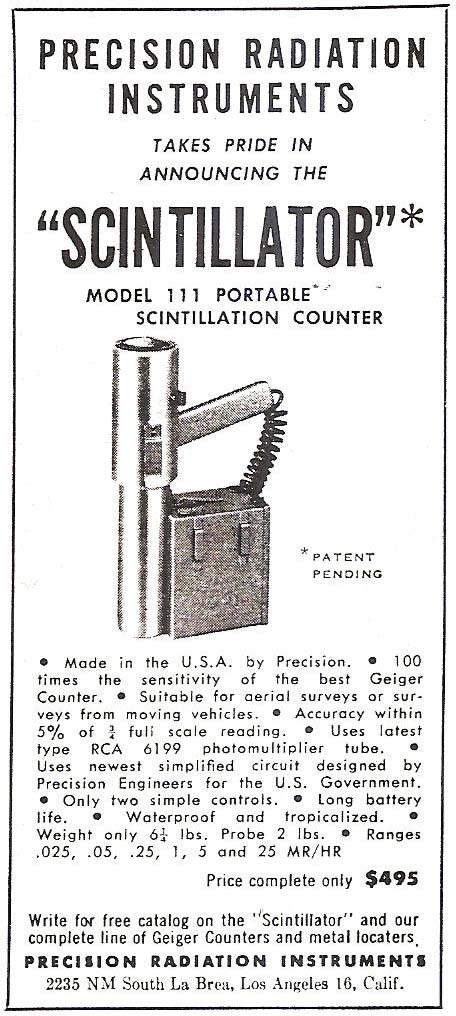
PRI Model 111 Ad 1952

PRI Model 111 Scintillator 1954
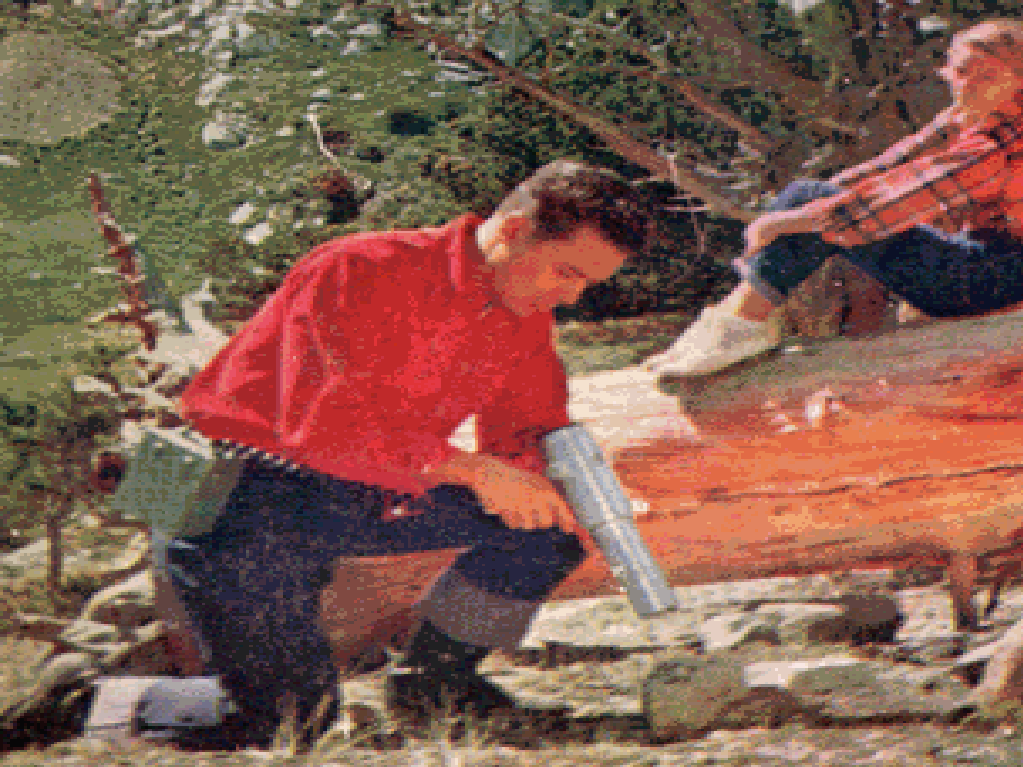
PRI Model 111 1954

PRI Model 111 1954
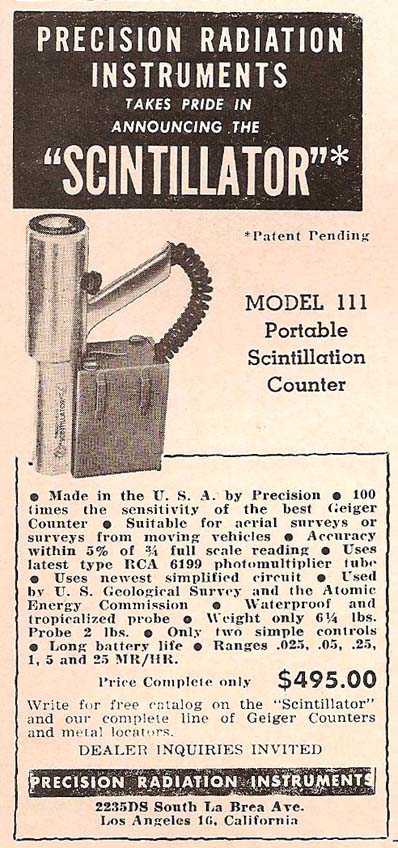
PRI Model 111 Ad 1954
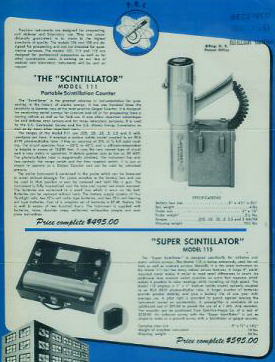
PRI Models 111 and 115 Flyer 1950's
The Model 111B “Scintillator” and “De Luxe Scintillator” were introduced in late 1954. The detector had a “gun” type handle design.
The unique feature of this unit was the highly-polished chrome surface. It was the first “percent meter” to readout in percentage of uranium. The meter is large at 3” in diameter.The Model 111B Scintillator nose houses a 1.5” x 1” sodium iodide detector which is 200 times more sensitive than the standard GM tube. The photomultiplier tube is housed in a magnetic shield. This made the 111B an ideal tool for uranium exploration from moving vehicles and an airplane. The probe is also waterproof and tropicalized. The meter was calibrated for percent uranium. There were six scale settings from 0.025, 0.05, 0.25, 0.5, 2.5 and 5 mR/h. The battery box can be detached and carried on the belt and weighs less than 4 lbs. It used four 1.5V flashlight, two 22.5 and two 67.5 volt batteries. The probe size is 3-3/4” x 13.5” and weighs 7.5 lbs. The battery box is 5-5/8” x 4-5/8” x 3”. A red flag warning signal guards against leaving the instrument turned on. The unit is easy to use by untrained personnel. It sold for $495 in 1954. In 1955, the Model 111B was offered by the Radiac Company as the “Percentometer” which allowed a direct reading for on-the-spot uranium radioactive material assays.
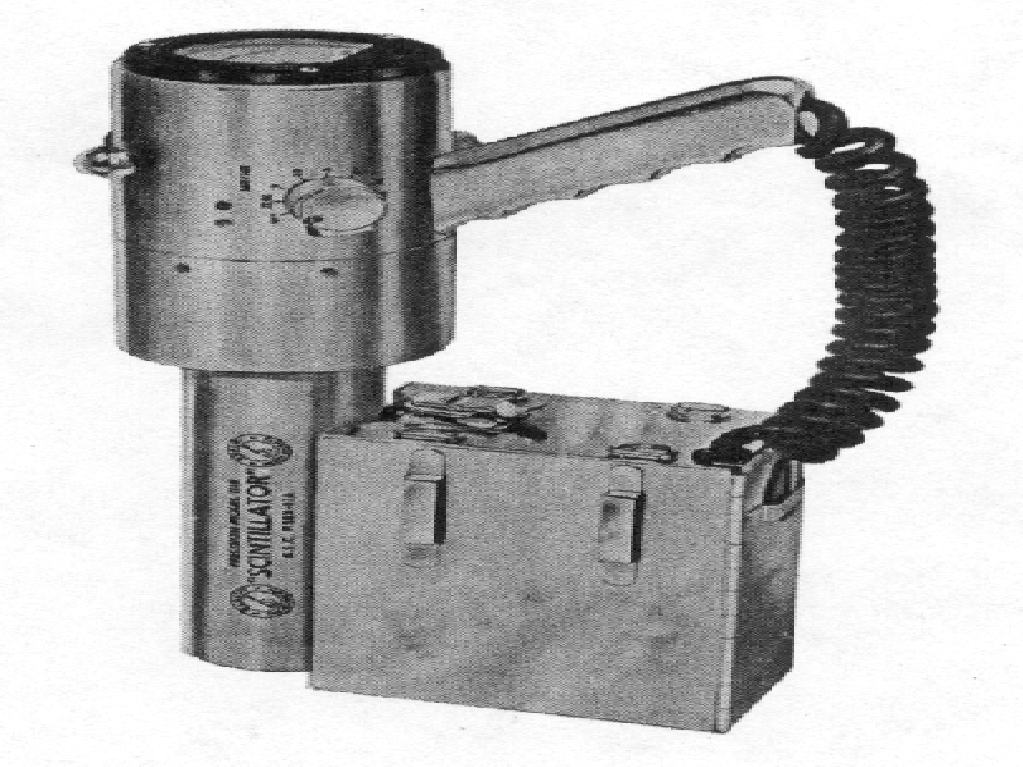
PRI Model 111B De Luxe Scintillator 1955
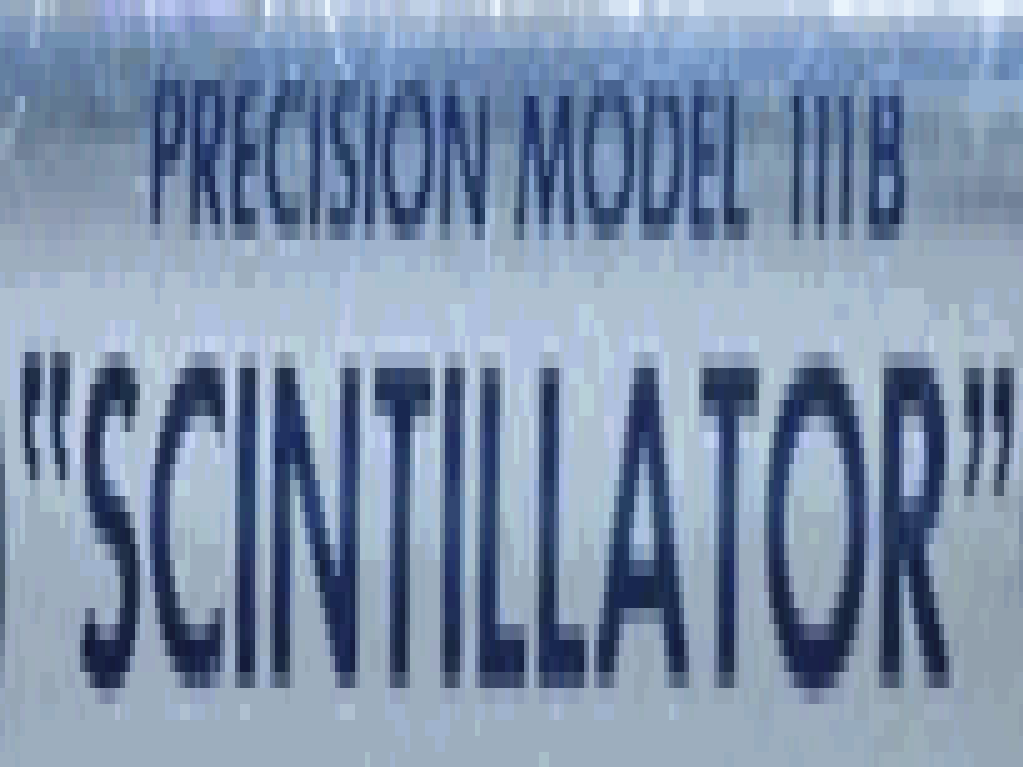
PRI Model 111B Scintillator
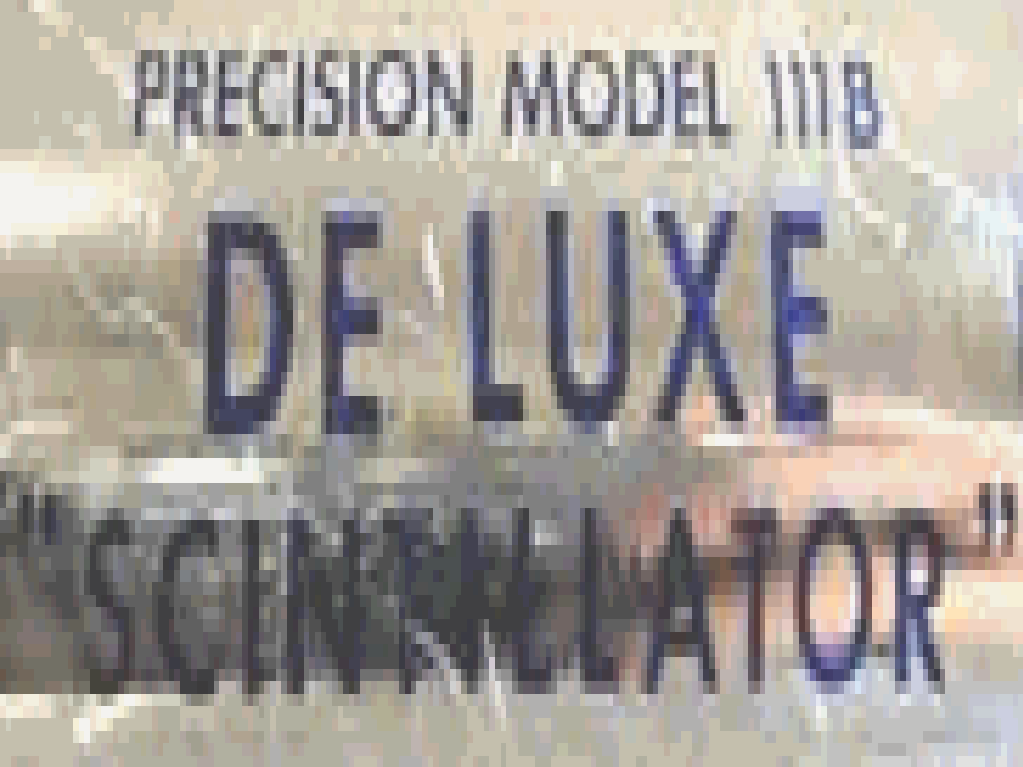
PRI Model 111B De Luxe Scintillator
PRI Model 111B Box Cover 1954
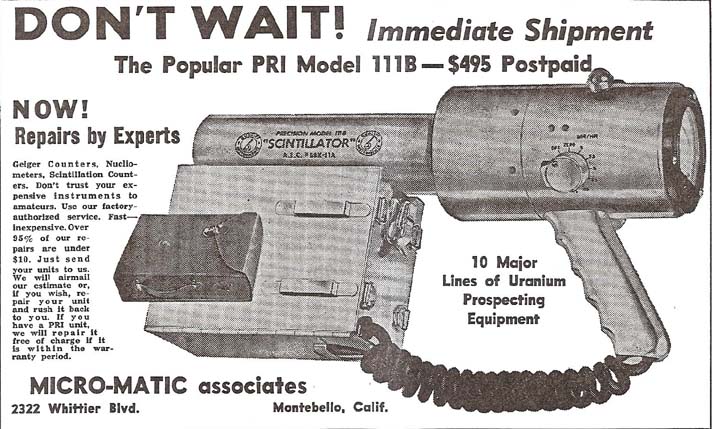
PRI Model 111B Scintillator Ad 1955

PRI Model 111B Deluxe Ad 1955
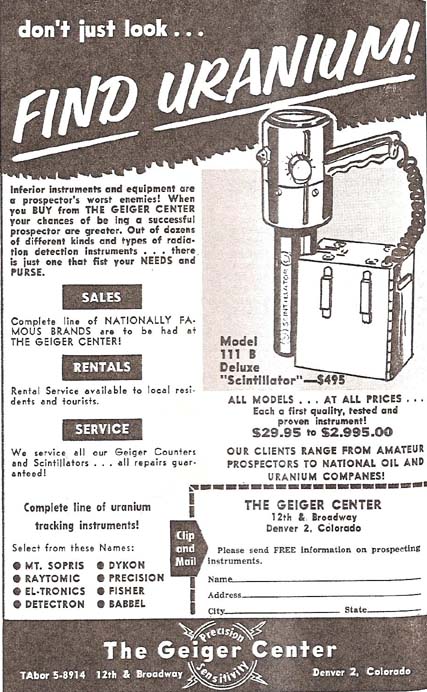
PRI Model 111B Deluxe Ad from The Geiger Center 1955
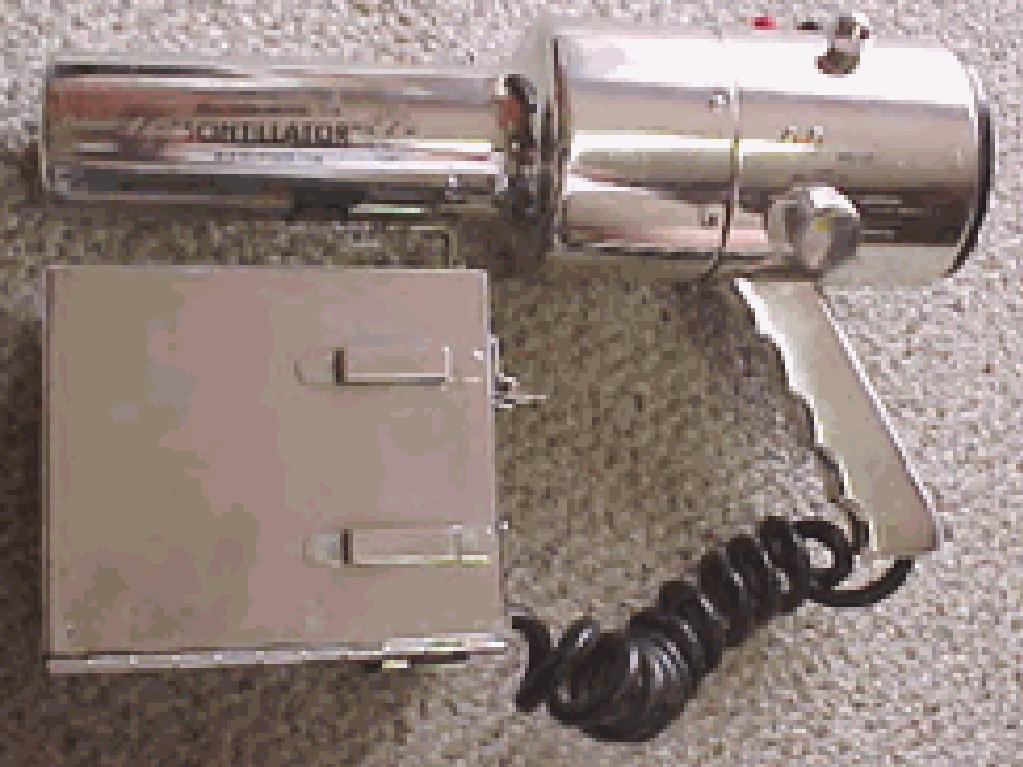
PRI Model 111B 1954
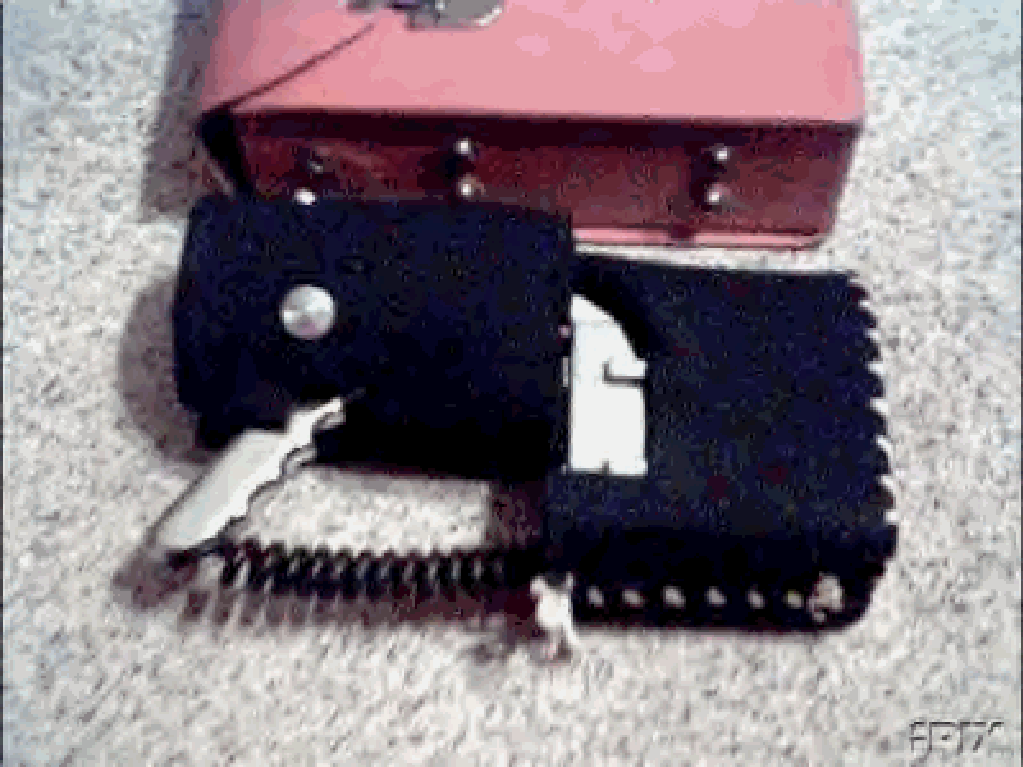
PRI Model 111B with Holster
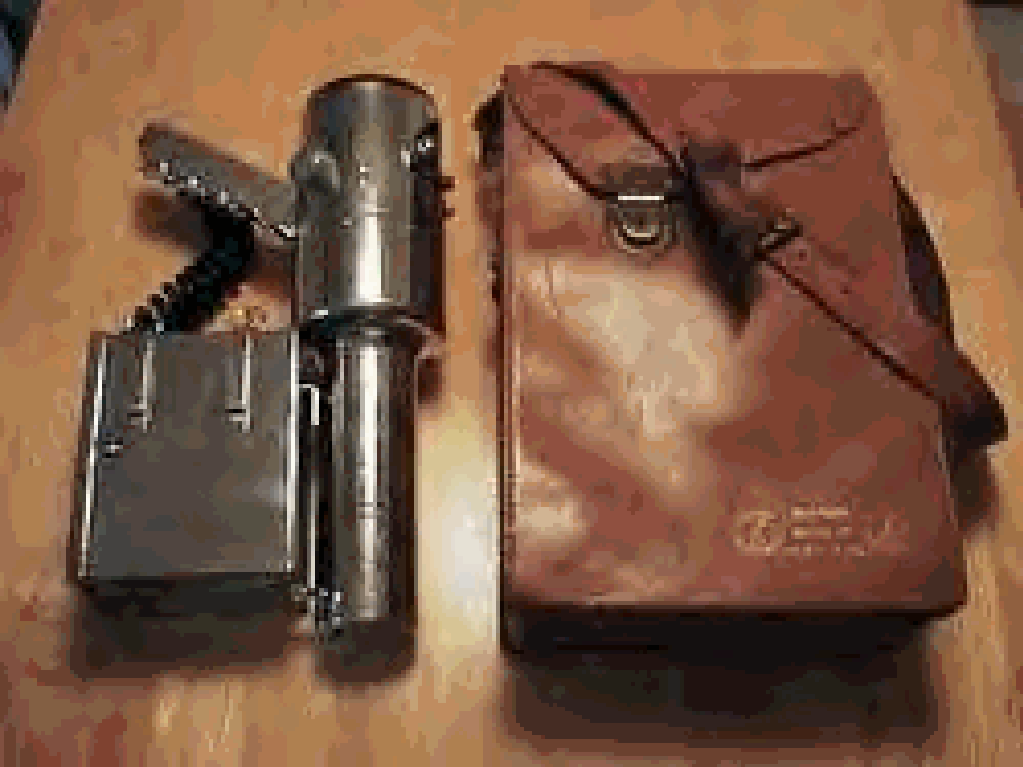
PRI Model 111B with carrying case 1954
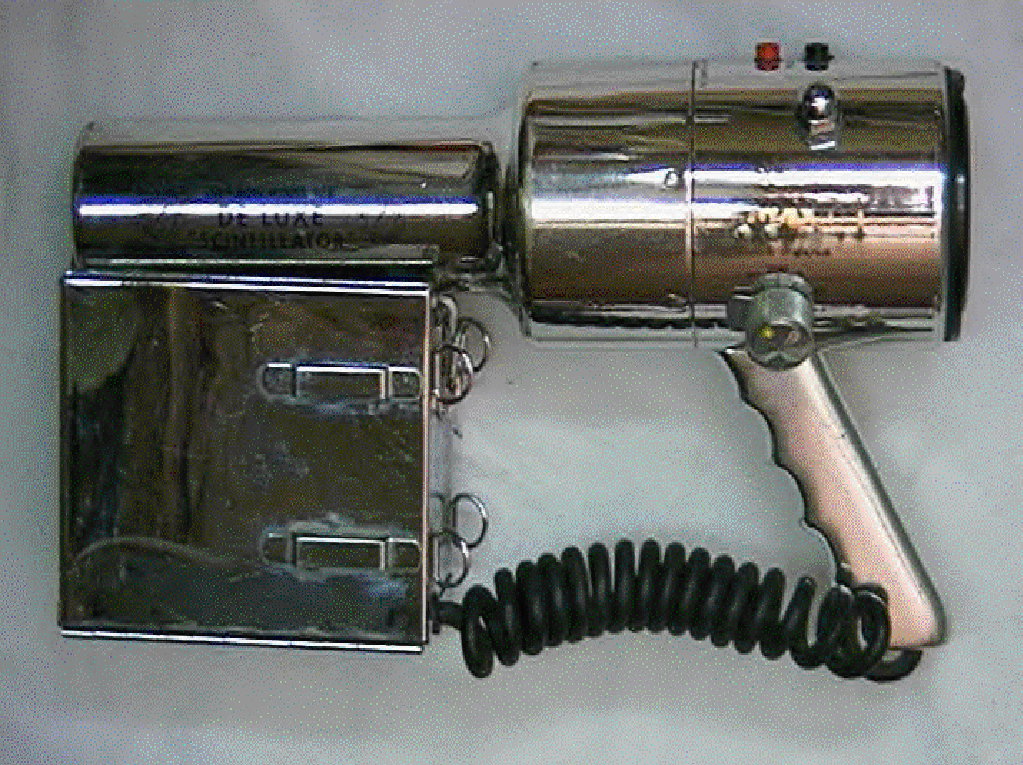
Precision Radiation Instruments Chrome 111B
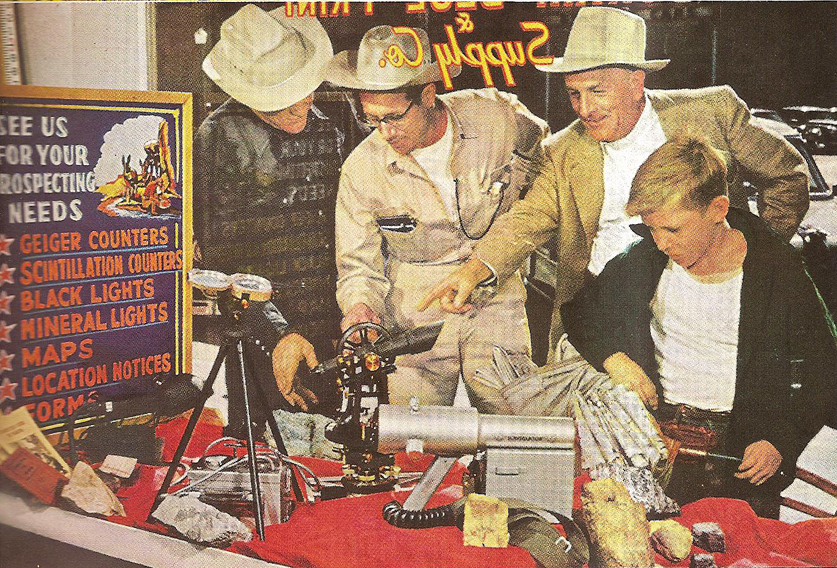
Prospecting with a PRI Model 111B 1950's
The Model 111B was so sensitive it was often used in cars for prospecting along roadways and trails.
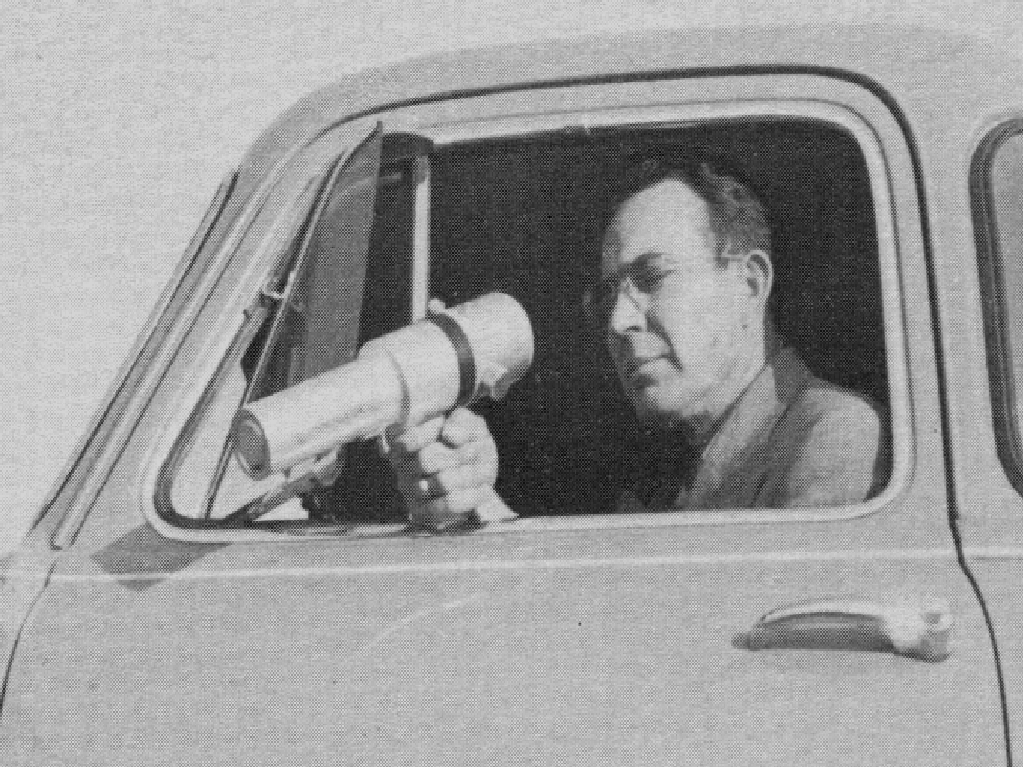
PRI Model 111B operated from car 1955
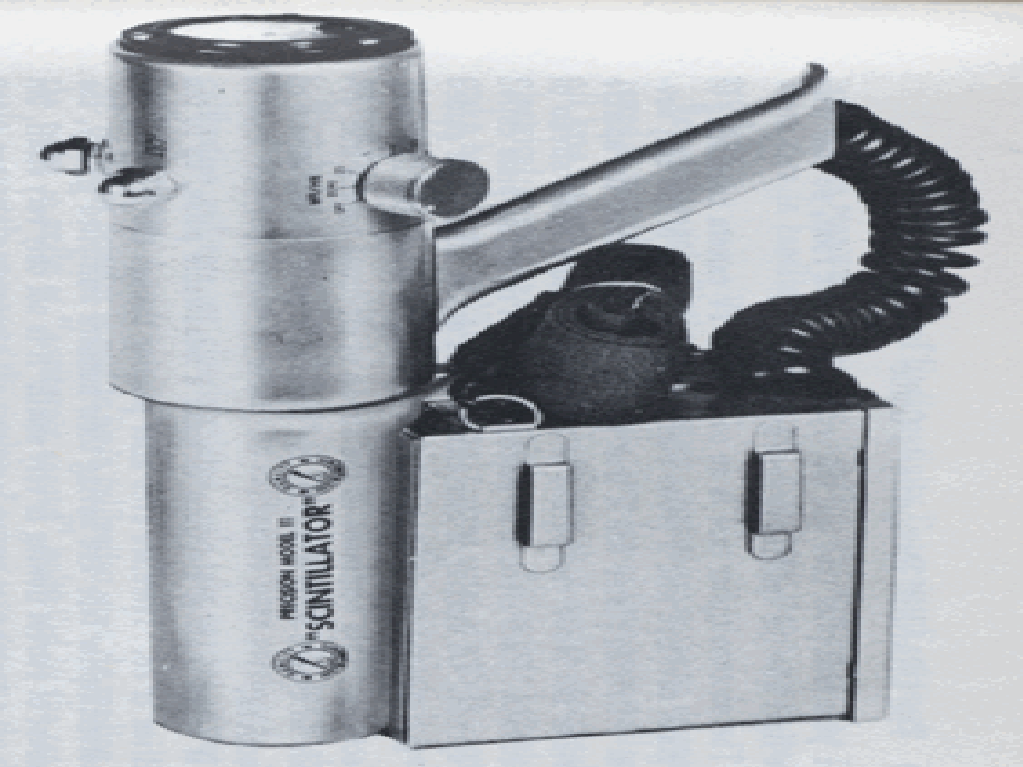
PRI Model 111B 1955
The PRI Model 111C was a Custom “Scintillator” Percentometer offered in 1955. It was similar to the Model 111B in size but contained a 2-1/4” diameter x 1” sodium iodide crystal. The crystal provides twice the sensitivity of the Model 111B. The meter range was 0.01, 0.025, 0.05, 0.1, 0.50 and 2.5 mR/h. It sold for $695 and included a deluxe carrying case.
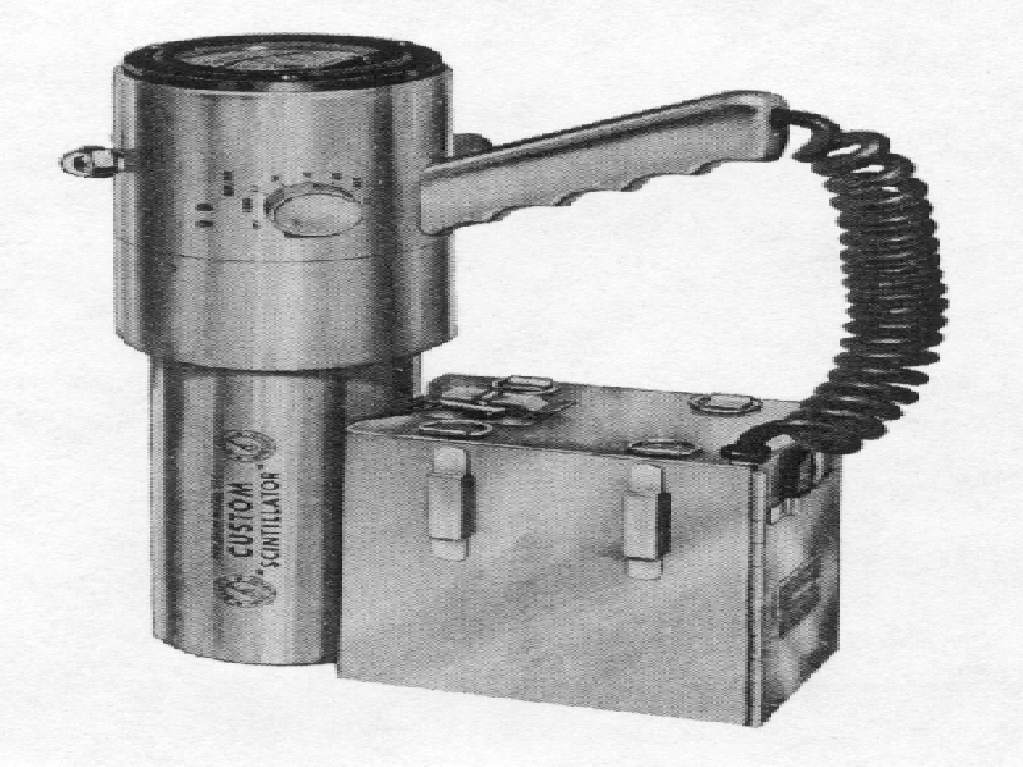
PRI Model 111C Custom Scintillator 1955
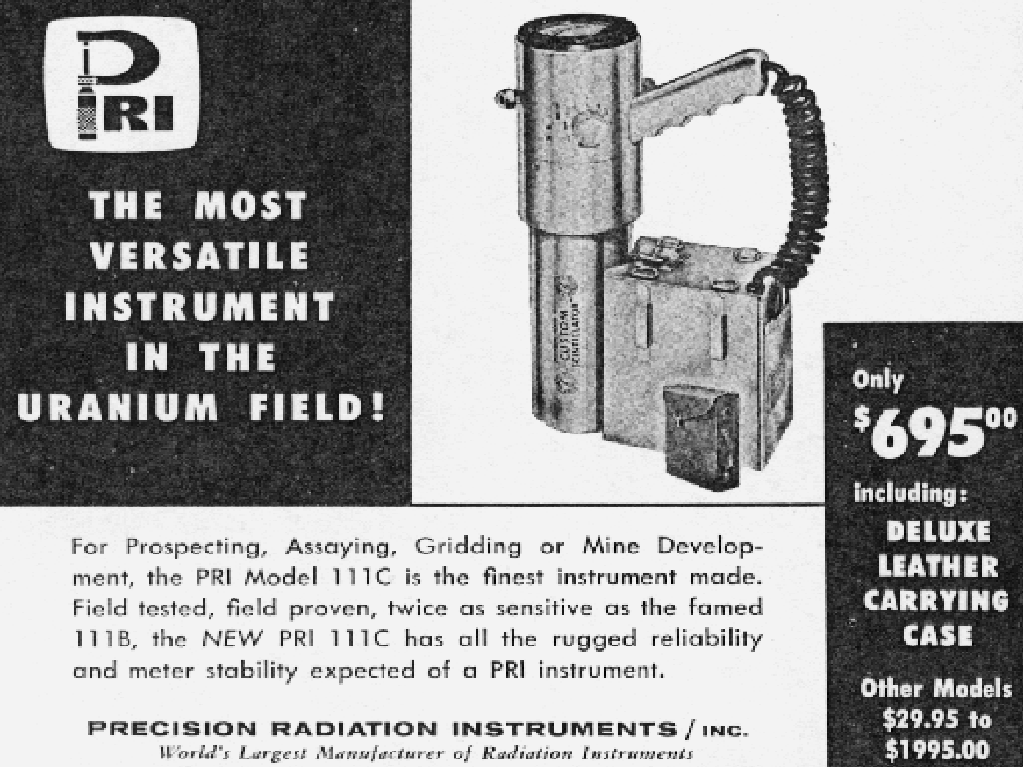
PRI Model 111C 1955
The PRI Model 112 was introduced in 1952. It was a ratemeter type scintillation counter designed for use in the medical or laboratory environment. It was the first portable instrument ever made for thyroid uptake studies and brain tumor localization. The ranges are 0.025, 0.05, 0.25, 1.5 and 25 mR/h. It sold for $695 in 1955. It weighs 15 lbs.
Need photo
PRI Model 112 1952
There is no indication of a Model 113.
The Model 114 is a scintillator probe for use with a scaler or ratemeter.
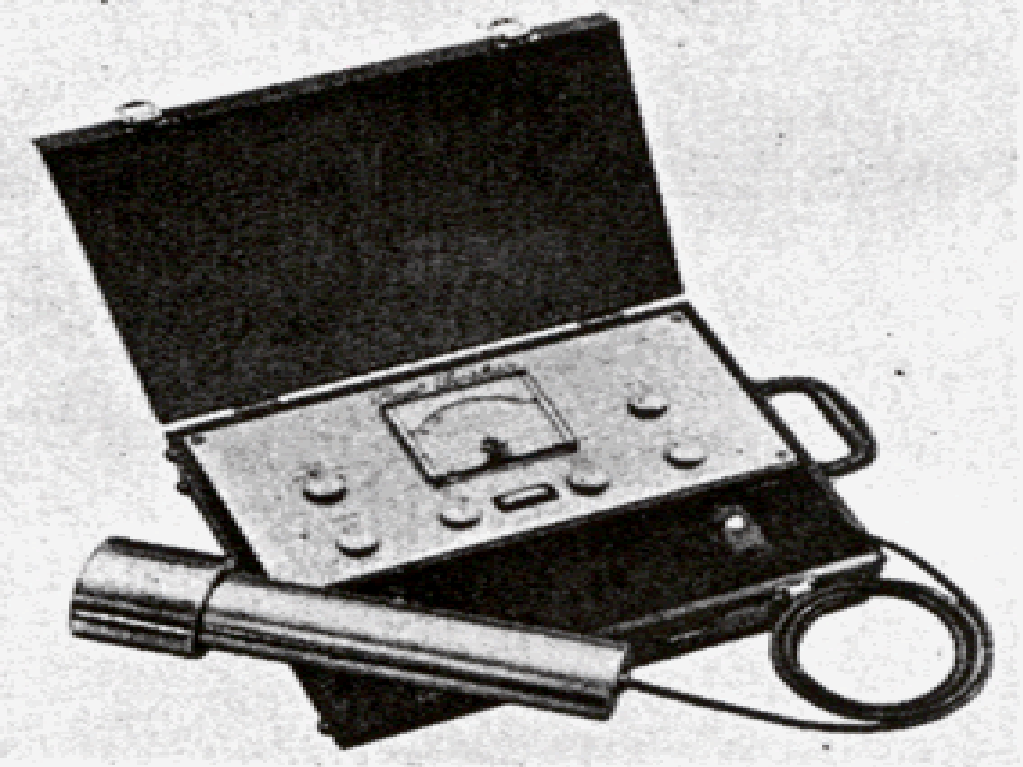
PRI Royal Scintillator 1947
The Royal Scintillator was initially introduced in 1947. The unit is a scintillator probe with accompanying control unit in a briefcase. An improved version of the unit was still be offered in 1955. The advertisement asked “Why Search for Uranium with a Horse and Buggy?”
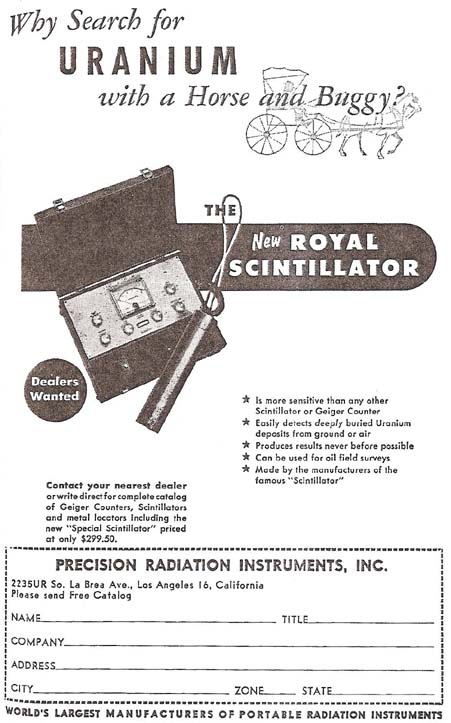
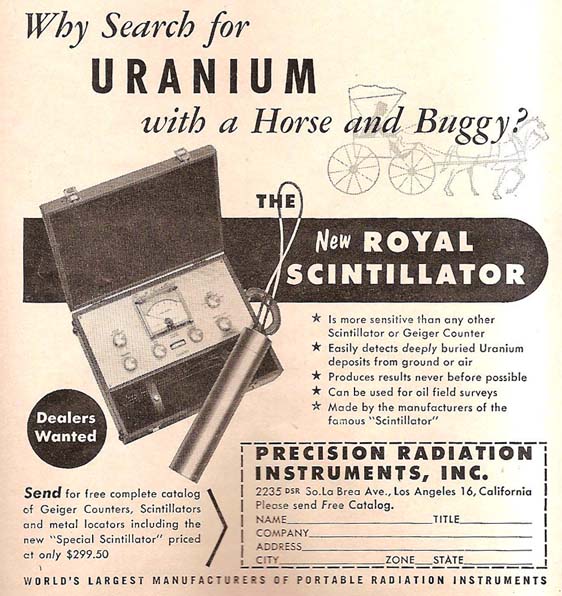
PRI Model 118 Ad 1955 (left) and (1954 (right)
The PRI Model 115 “Super Scintillator” was offered in 1953 as a mobile or airborne version of the Model 111. The crystal was 1” x 1” sodium iodide. It would give 250,000 counts per minute in a 1 mR/h field. It had a range from 0.025, 0.05, 0.25, 1, 5 and 25 mR/h. It had a large 4” panel-mounted meter connected by a 6’ cable. The unit has an additional meter mounted on the end of the case to provide visual display while walking with the instrument. It used eight 1.5, two 22.5 and four 67.5 volt batteries. The unit is 5” x 11” x 14.5” and weighed 15.5 lbs. It could be connected to a strip chart recorder. It was a scintillator for car and plane surveying. It sold for $595 in 1954.
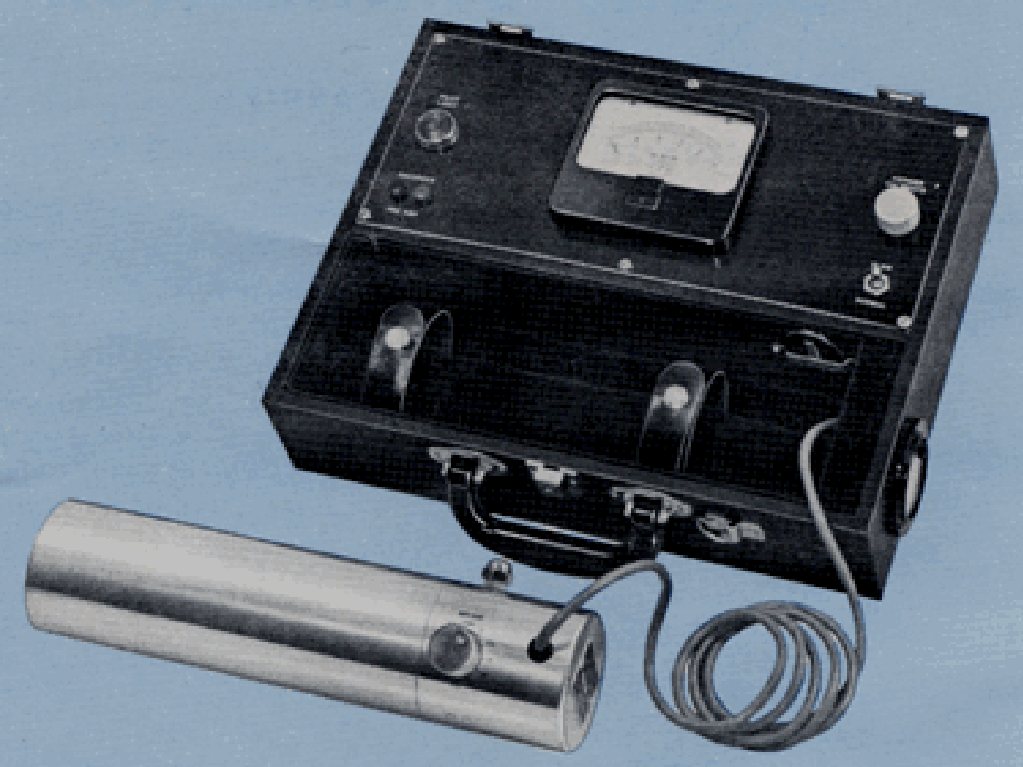
PRI Model 115 1955
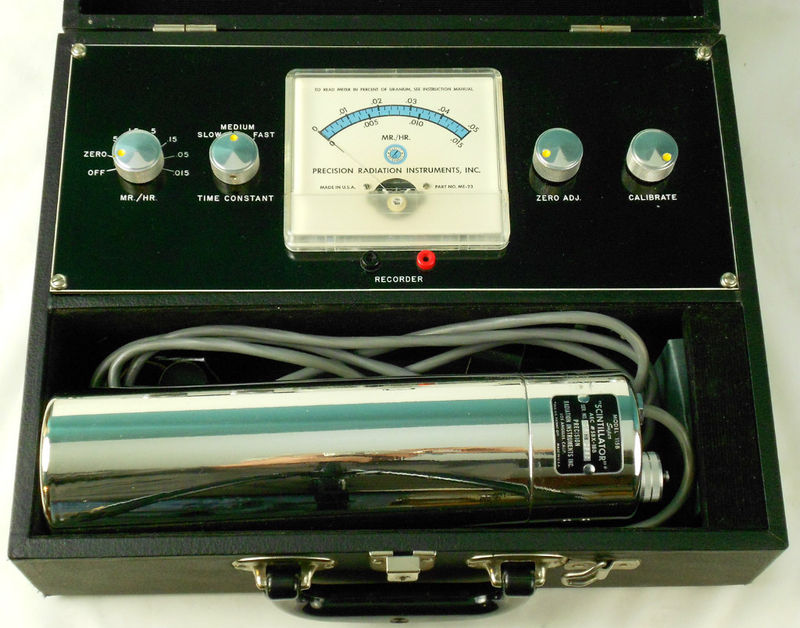

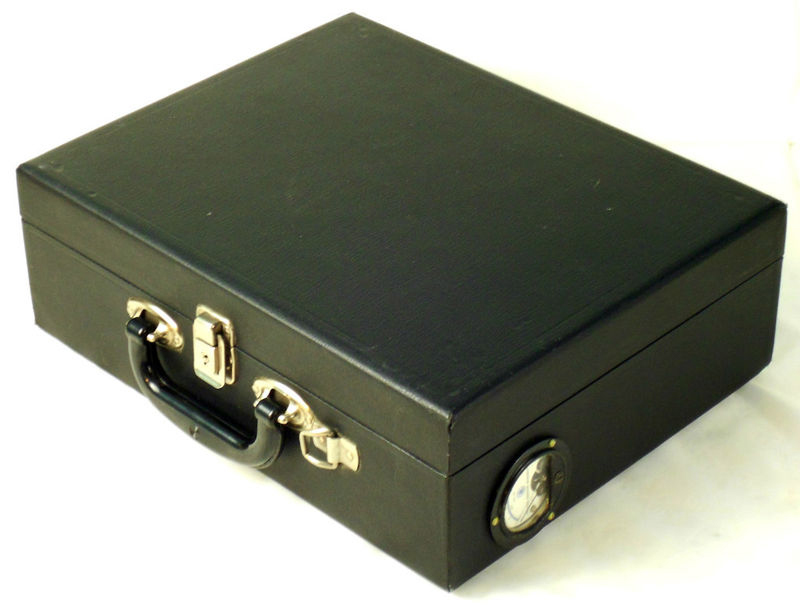
PRI Model 115 1955
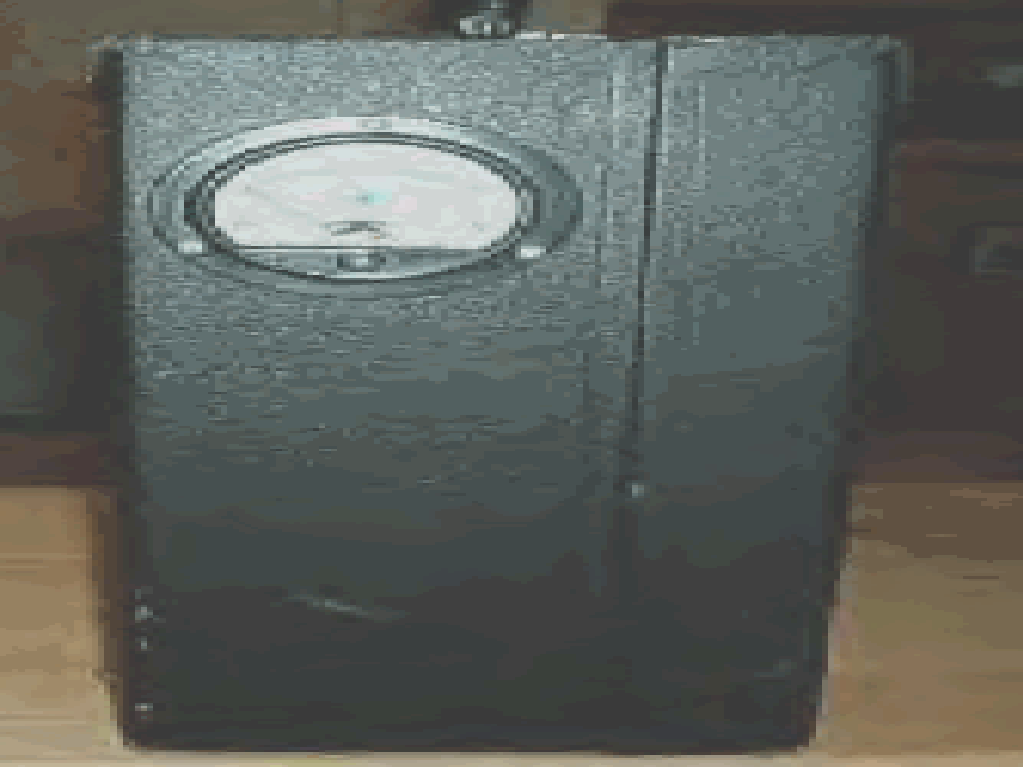
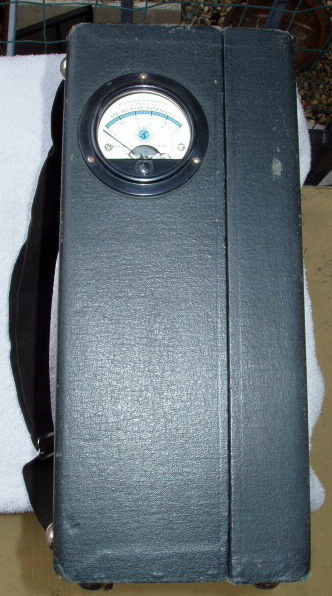
PRI Model 115 Scintillator 1955
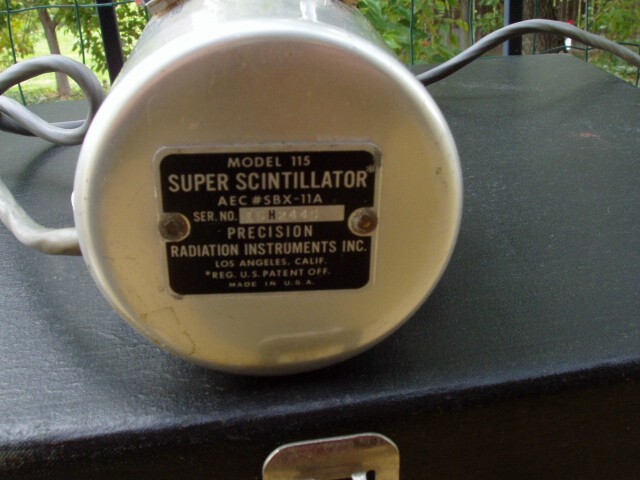
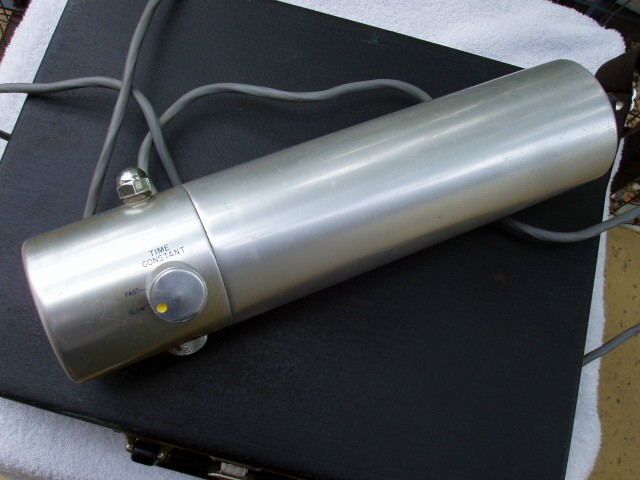
PRI Model 115 Super Scintillator 1955
The Model 115B Super Scintillator was offered in 1956. The unit offered more panel adjustments including time constants and zero adjust. The unit had the famous percent meter. The meter was 4" square and panel mounted making small differences easier to read. The probe is connected via a 6 ft cable. It has a very fast time constant for moving measurements. The case size is 5 in x 11 in x 14-1/4 in and weighed 16 lbs.
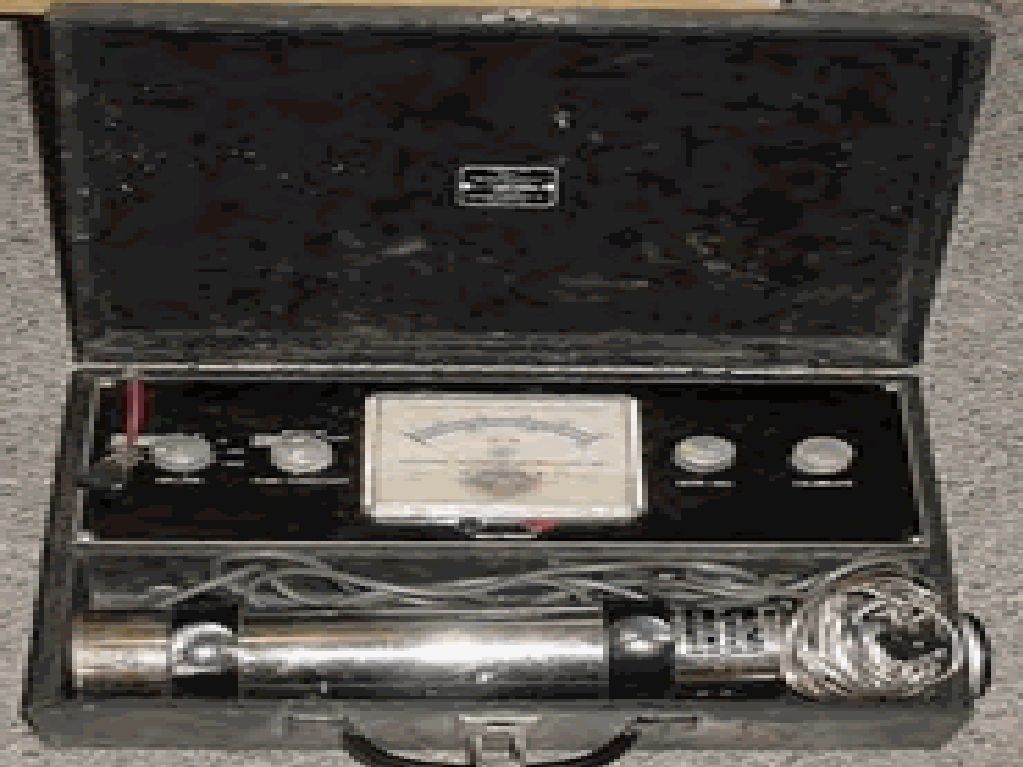
PRI Model 115B Scintillator 1956
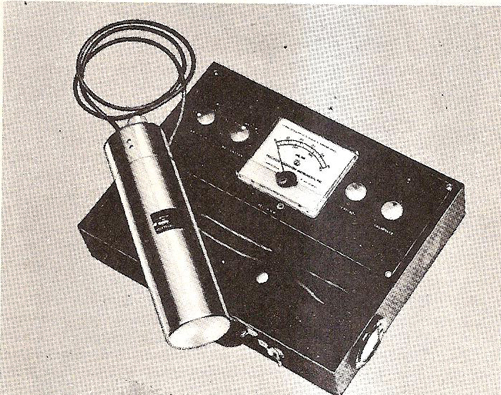
PRI Model 115B Scintillator 1950's
The PRI Model 115C Super Scintillator was offered in the late 1950’s as an instrument for prospecting from a moving vehicle or airplane. It had a large sodium iodide detector. It used eight 1.5, three 67.5, and two 221.5 volt batteries. It had a range selection of 0.01, 0.025, 0.05, 0.1, 0.5, and 2.5 mR/h. It sold for $795 in 1960.
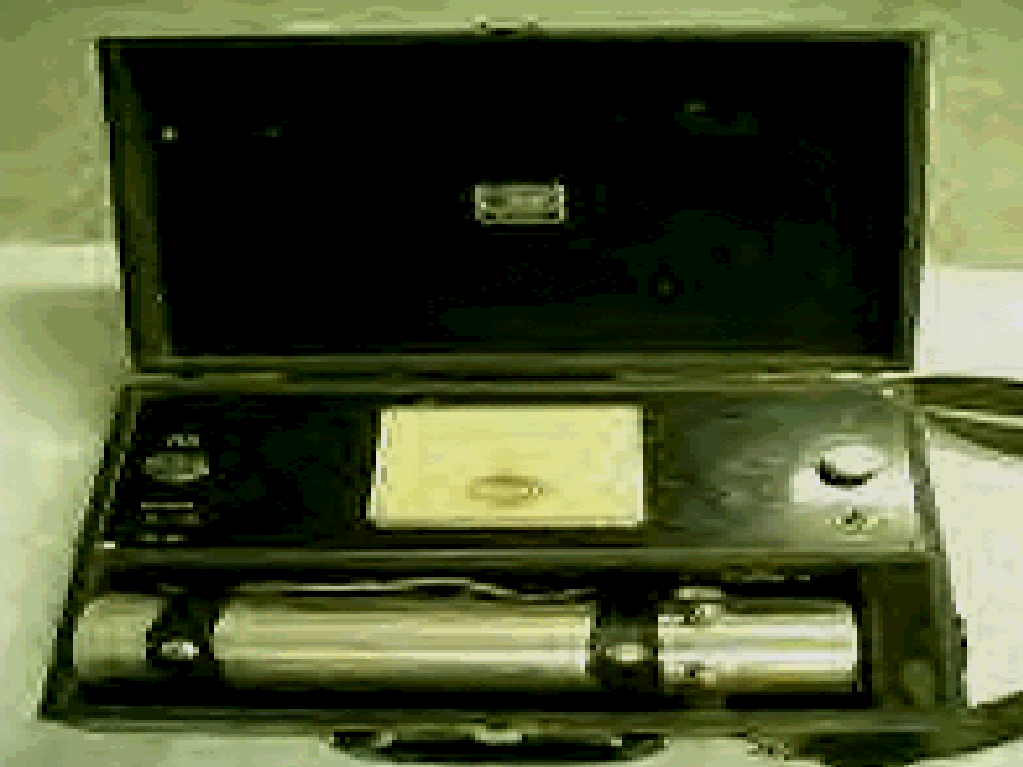
PRI Model 115C Super Scintillator late 1950’s
The Model 116 was not a radiation detector, but an amplifier designed to increase the output of a Geiger or Scintillation counter to drive a auxiliary recorder. It could be used with the Model 112, 115, 118 and 120. The unit was portable and shaped like the Model 106. It was 3.5” x 4.5” x 6.5” and weighed 4.5 lbs. The unit sold for $99.50 in 1955.
The PRI Model 117 “Special Scintillator” was a scintillation detector introduced in September 1954 for uranium exploration. It was not as sensitive as the Model 111. It contains a 0.5” x 1” sodium iodide detector. The operating ranges are 0.025, 0.05, 0.25, 0.5, 2.5 and 5 mR/h. The unit was ultra sensitive, low cost, and lightweight. It used four 1.5 volt flashlight batteries, one 22.5 volt hearing aid battery, and two 45 volt batteries. It had a red pilot light on the front to prevent the instrument from being left in the on position accidentally. It came with a calibrated radium source. The Model 117 has a “Sample Check Spot” for use in calibrating with the included radium source. The unit was 4.5” x 7.25” x 7” and weighed 6-3/4 lbs. It sold for $299.50 in 1955.
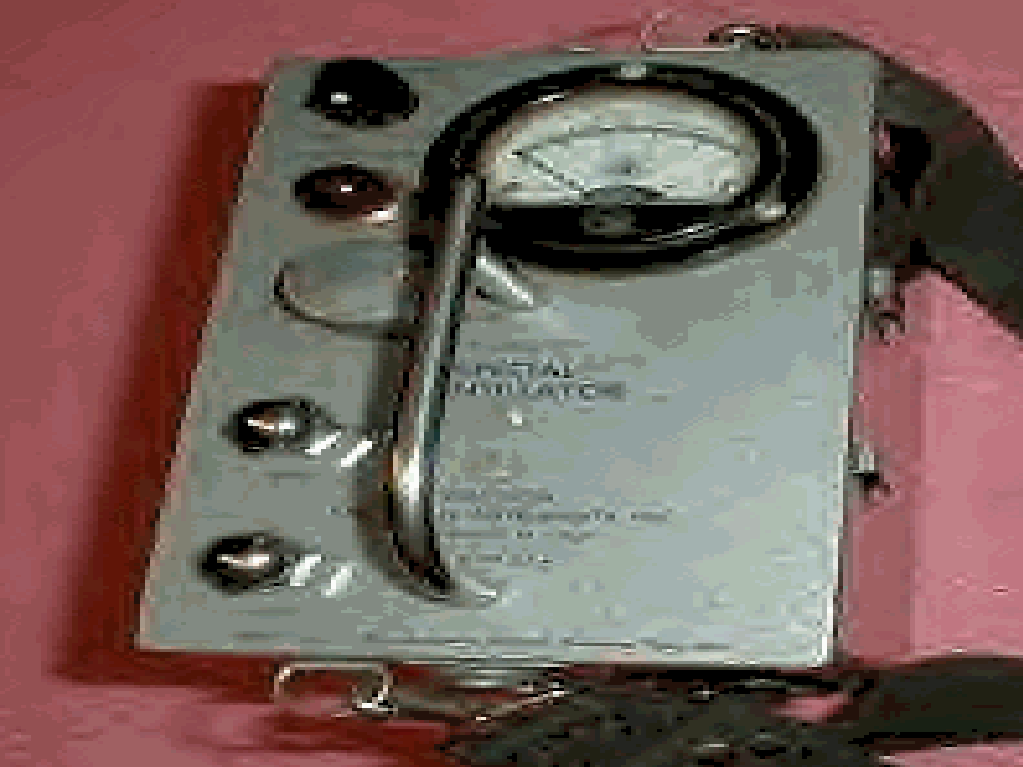
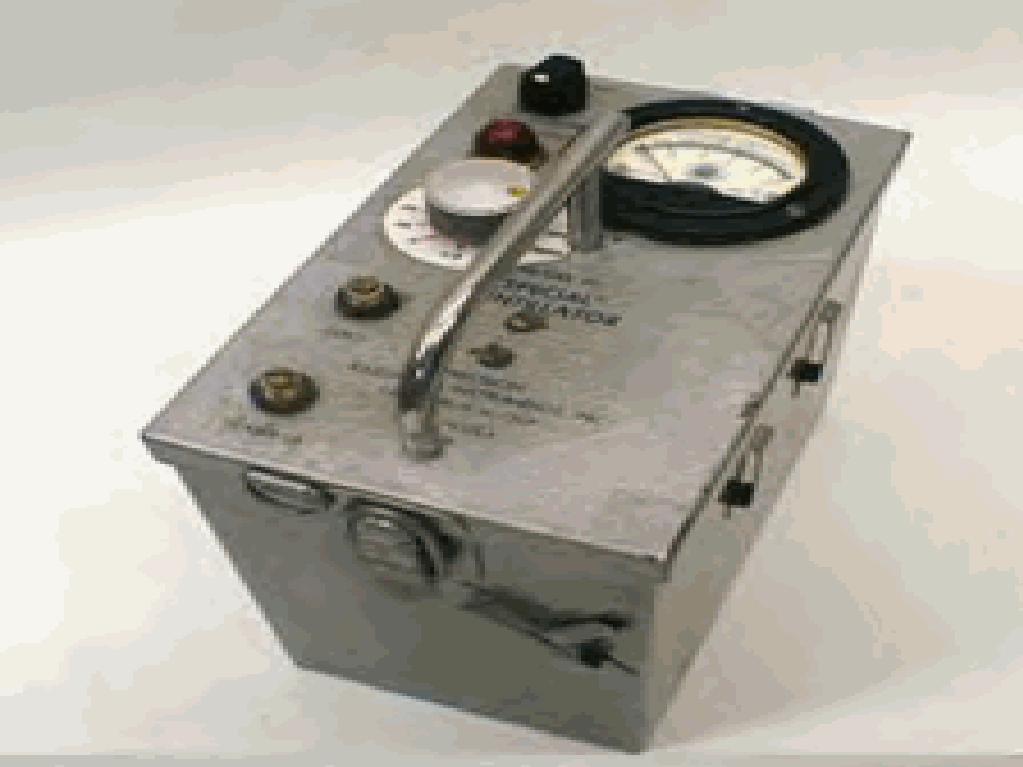
PRI Model 117 Special Scintillator 1954
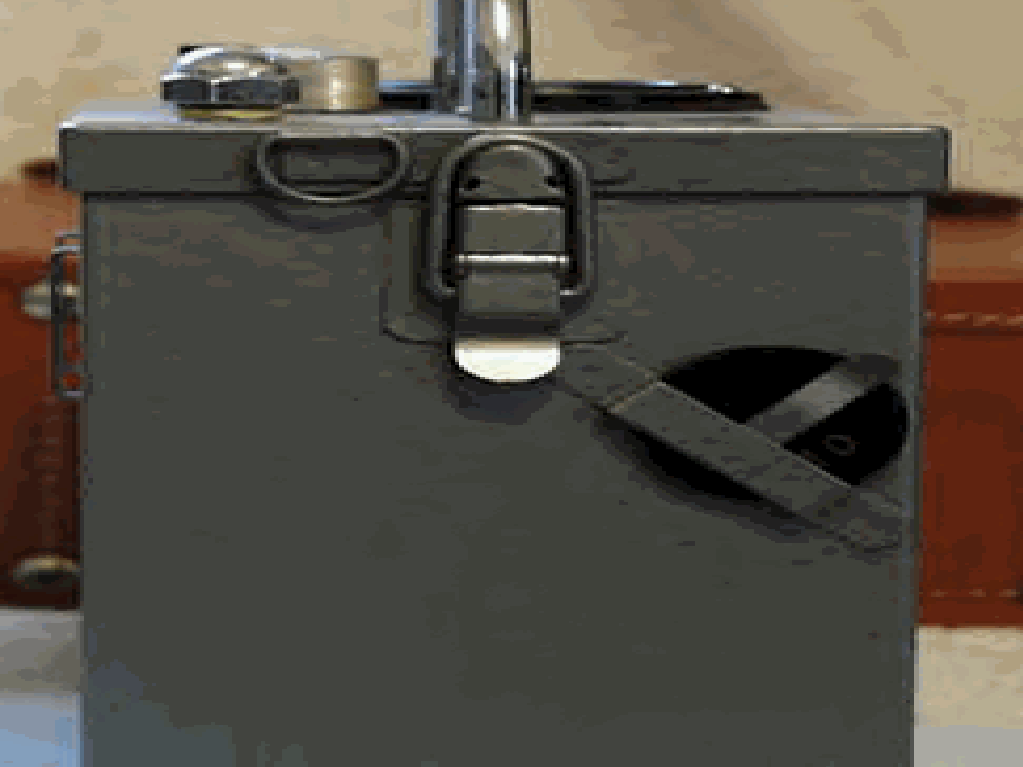
PRI Model 117 with test source 1955
The Model 117B was later introduced in 1955. The neon light on the top of the unit is a pilot light. It does not indicated radioactivity. The Model 117B had a 1.5” diameter x 1” sodium iodide crystal. It had six ranges of 0.025, 0.05, 0.24, 0.5, 2.5 and 5 mR/h. It would give 65,000 counts per minute in a 1 mR/h field. It was simple to operate and can be used by untrained persons. It was waterproof and tropicalized. The photo tube and crystal are shock mounted. A calibrated radium sample is provided for calibration in the field. It came with a saddle-grain leather carrying case. The unit requires four 1.5, one 22.5 and two 45 volt batteries. The unit was 4-1/2 in x 7-1/4 in x 7 in and weighed 6-3/4 lbs.
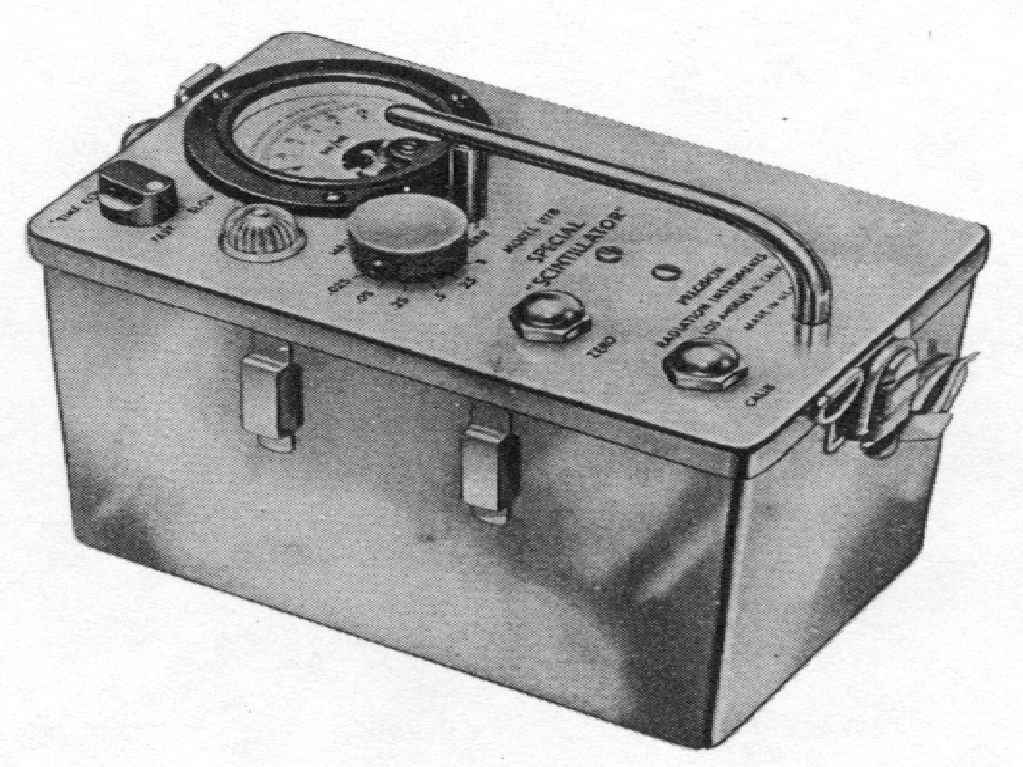
PRI Model 117B Special Scintillator 1955
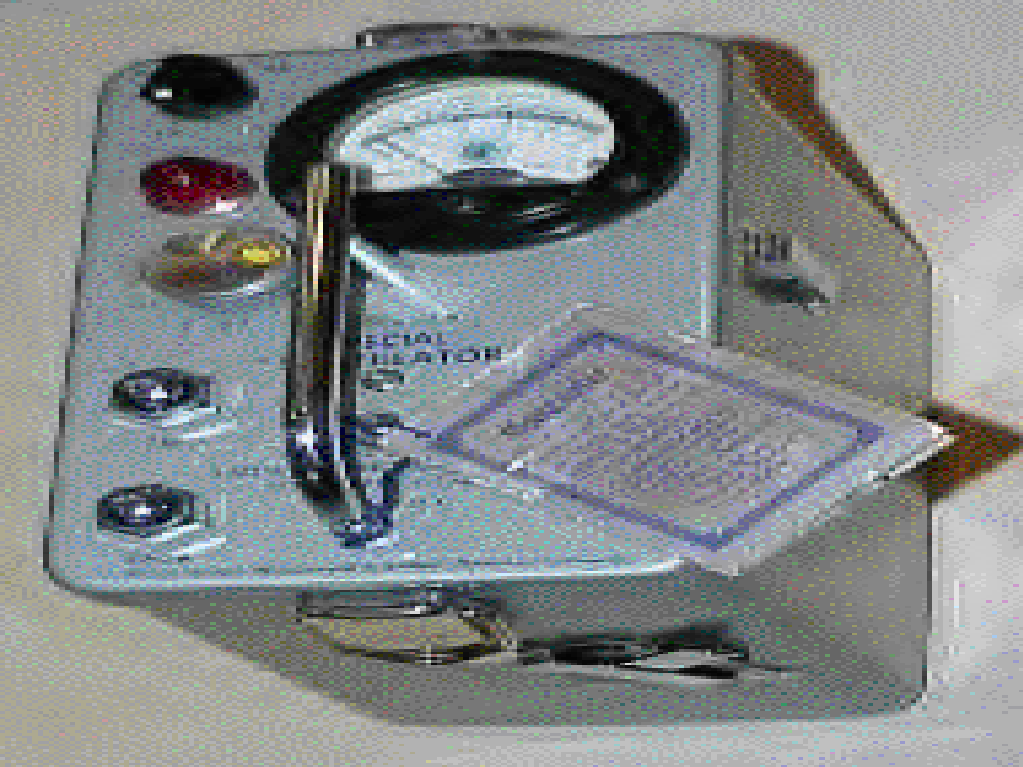
PRI Model 117B 1955
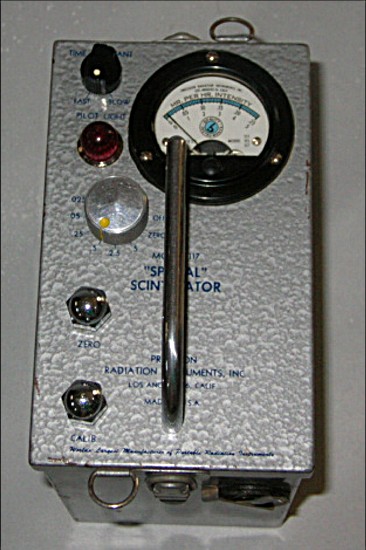
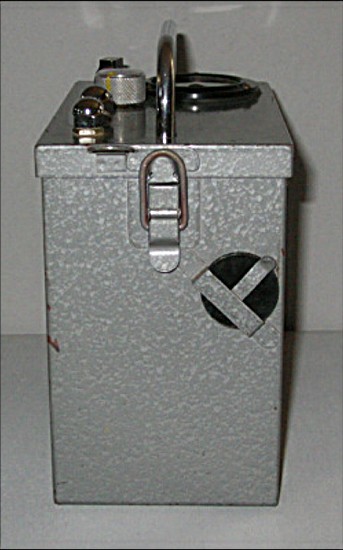
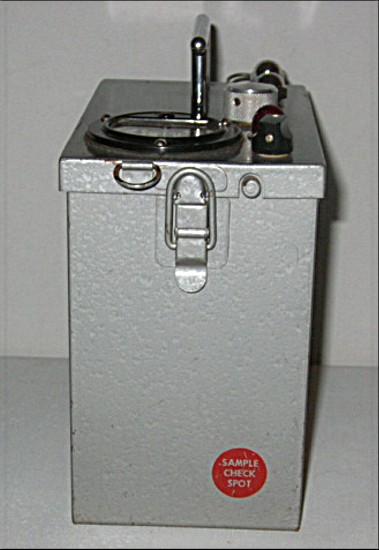
PRI Special Scintillator Model 117 1955
The Model 118 “Royal Scintillator” scaler-ratemeter was still being offered in 1954 for $1995. It has five time the counting rate of the Model 111. It had a leather case and a protective cloth cover. The probe had a 12’ cable. The thalium activated sodium iodide crystal was 2.25” diameter. It had a range from 0.01 to 1 mR/h with a counting rate to 500,000 per minute. The unit has ranges of 0.01, 0.025, 0.05, 0.1, 0.25, and 1 mR/h. It could operate as a survey meter or scaler. The time constant could be set to 1, 5, 15 and 45 second for ground, mobile or aerial surveying. For aerial surveying, the speed should be less than 100 mph at a height of 50-100 feet. The unit comes with an extra external meter and extension cable. It can be clipped on the unit while walking or on the dashboard of a car. The meter is illuminated for night use. The unit requires 14 flashlight batteries, two 22.5 and five 67.5 volt batteries. It comes with a calibrated radioactive sample for calibration. The Model 119 lead shield could be used with the Royal to provide some directionality. The Model 116 preamplifier could be use to attached a recorder. The unit is 13” x 17” x 5” and weighed 24 lbs.
The Model 118 could be supplied with a 7” diameter sodium iodide crystal. The counting rate was extended to 9.5 million cpm in a 1 mR field. It sold for $4995 in 1955. It was advertised as the “Most Sensitive Instrument Made”. Because of the size of the detector crystal, the Model 118 was the best instrument on the market for aerial prospecting. It was the result of extensive development to produce, regardless of cost, the best possible instrument that could be made for radioactivity surveying. I was designed specifically to measure the very small variations in gamma ray activity which enable the geologists to trace faults and other geologic features. Because of its enormous sensitivity, it is the finest instrument made for uranium surveys as well as for oil survey work. Measurements have shown that the radioactivity field above an oil or water deposit is unique and, as such, radioactivity can not only be used to survey for uranium but also for oil deposits. PRI wrote several technical papers on the process.
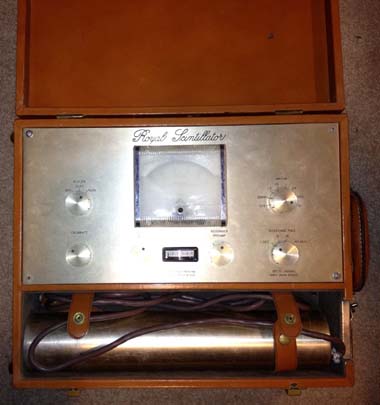
PRI Royal Scintillator Model 118 1954

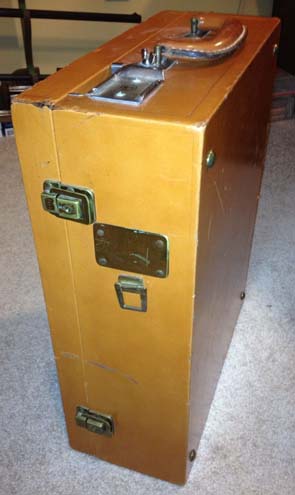
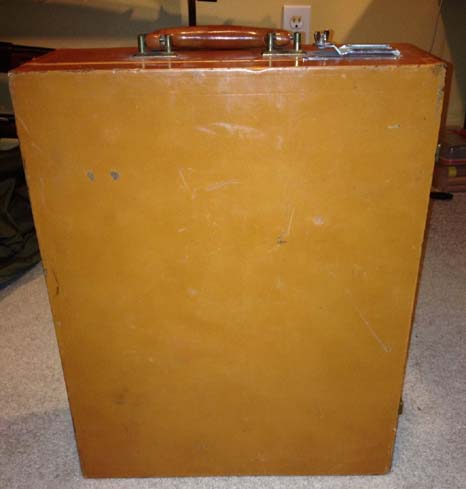
PRI Model 118 1950's
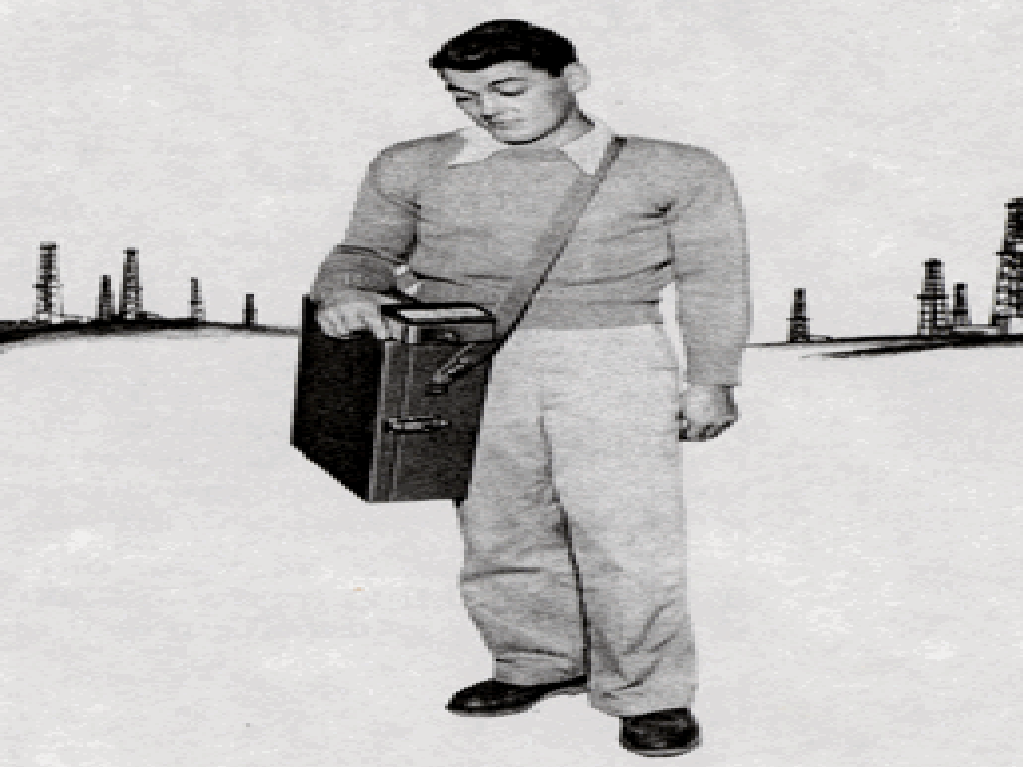
PRI Royal Scintillator Model 118 1954
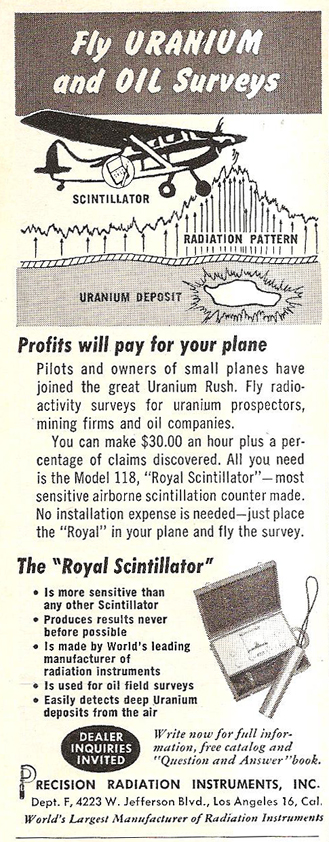
PRI Royal Scintillator Model 118 Ad for Aerial Prospecting 1955
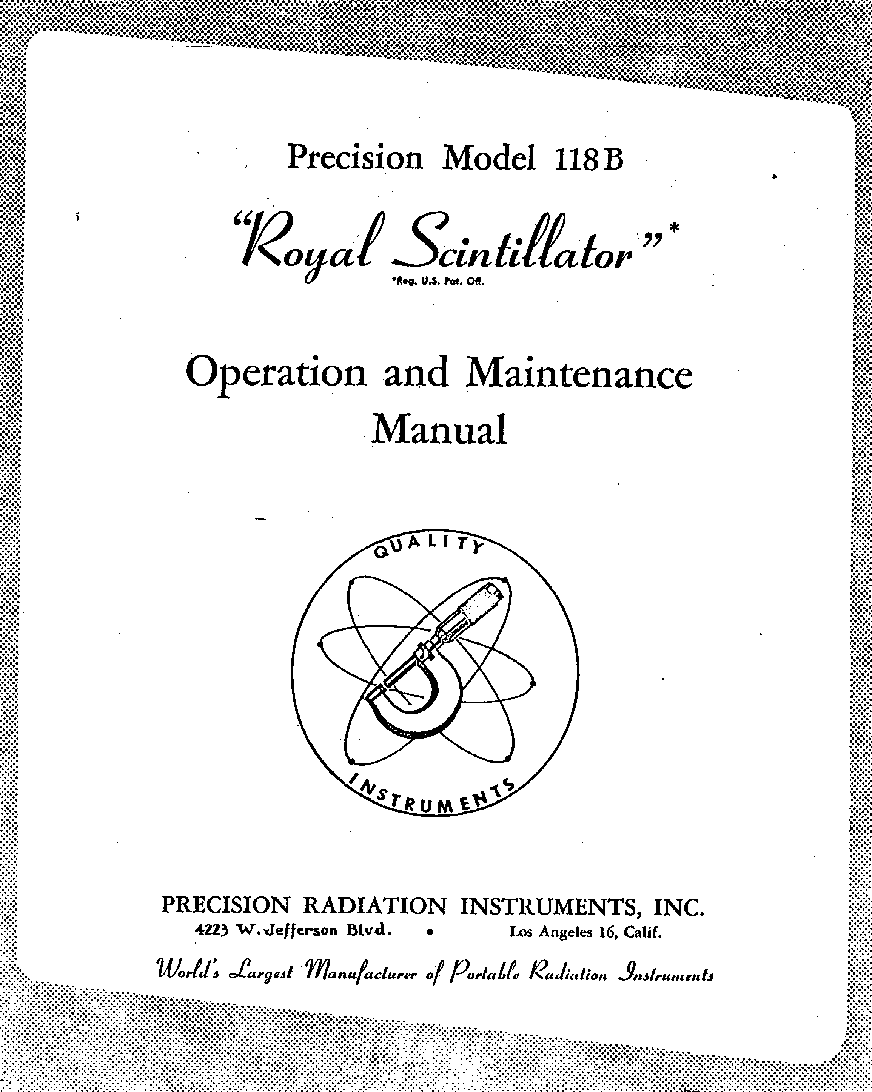
PRI Model 118B Operation Manual 1950's
The Model 119 was a “Lead Shield” or collimator designed for use with the Royal Scintillator. It would surround the detector with 1” of lead and provide directionality and reduced background. It weighed 38 lbs. and sold for $295 in 1955.
In 1955, PRI introduced a large volume scintillator which was housed in a box. The detector was on an extendable probe. It had a crystal 3.25” in diameter. It was rated to count one million cpm in a 1 mR radiation field.
The PRI Model 120 “Drill Hole” was a geiger counter introduced in 1955 for uranium prospecting of drill holes as deep as 1000’. It was essentially the Model 107B with the option to attach a long cable and drill hole probe. It had an extra drill hole probe and 50’ of cable. The drill hole probe was 7/8” in diameter. It sold for $289.50. It came with the standard Model 107 probe as well as the longer drill hole probe and long cable.
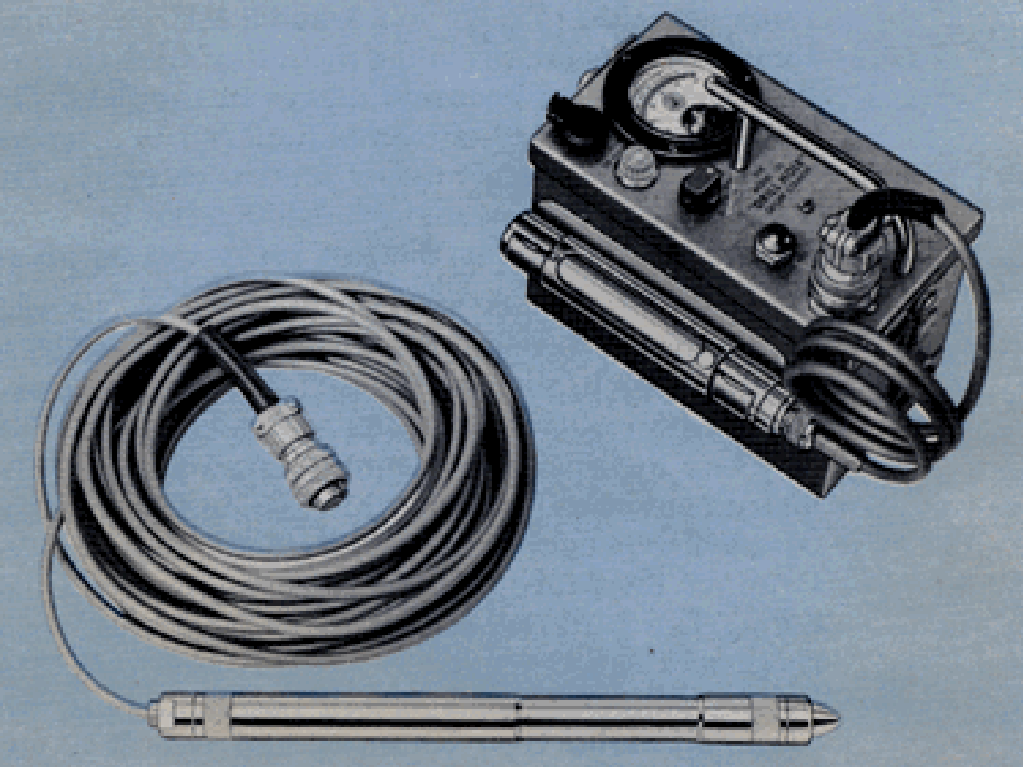
PRI Model 120 Drill Hole 1955
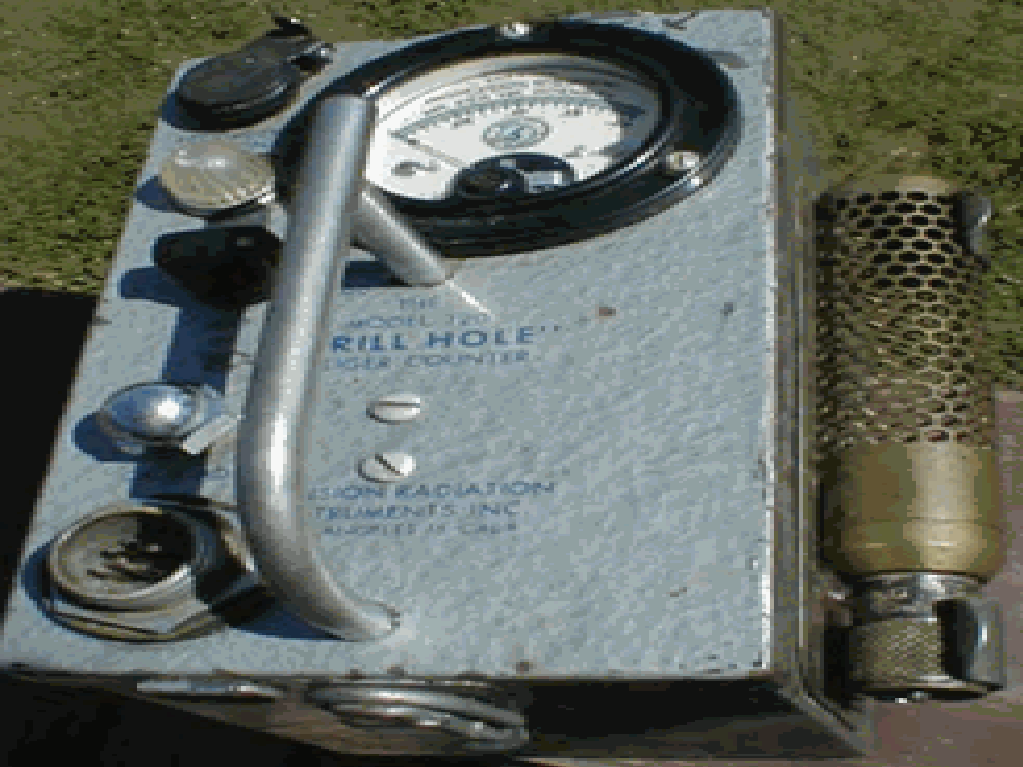
PRI Model 120 1955
PRI also produced the Model 121 “Drill Hole” Geiger counter in 1955. The unit could support measurements to 1000 feet. It came with three detachable probes - an end window GM with removable protective cover, a side window GM with sliding beta shield and a special probe (3/4" diameter) with a fifty foot cable. The Model 121 came with a long cable and a probe for inserting in drill holes to measure for radioactivity. The unit could also be outfitted with either an alpha-beta or beta-gamma. The scale was from 0.04, 0.2, 2 and 20 mR/h and could be calibrated for % uranium. The unit used two 1.5, one 45 and two 67.5 volt batteries. It was 3.75" wide x 4.5 " high by 7.5" long and weighted 6 lbs.
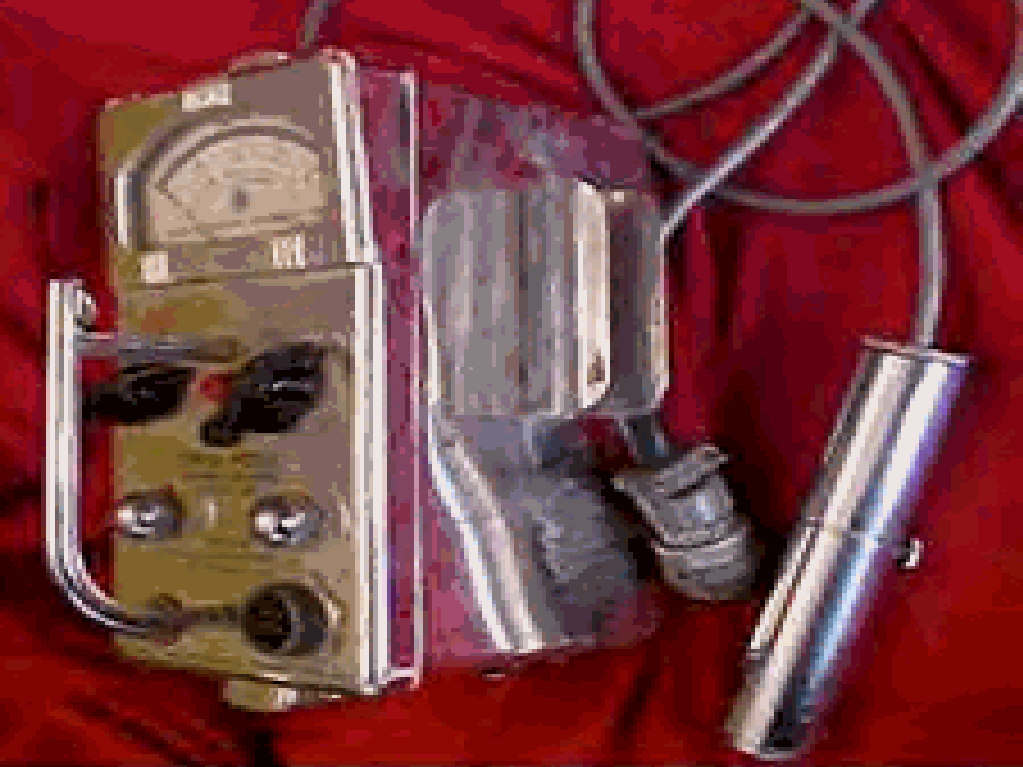
Precision Radiation Instruments 121 Drill Hole 1955
The Model 122 is the Drill Hole Probe for use with the Model 121 in 1955.
The PRI Model 123 “Squealer” was offered in 1954. It was based on the Model 121 unit. It produced a high pitch squeal when radiation was detected.
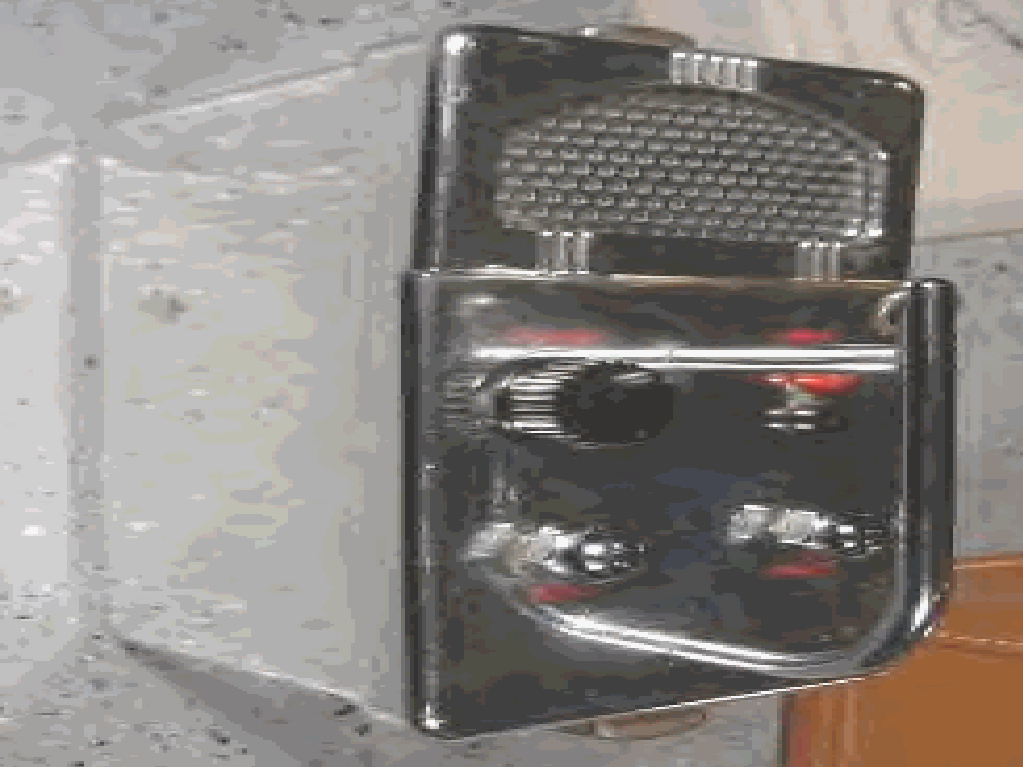
PRI Model 123 Squealer 1954
A PRI catalog from the early 1950's is shown to provide the variety radiation detection instruments offered during that period. They range from the small handheld units to the more expensive scintillation units.
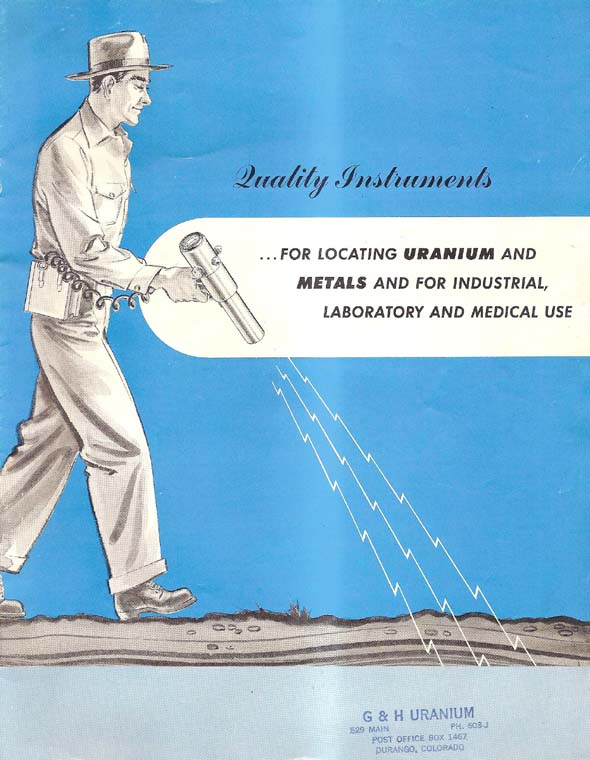
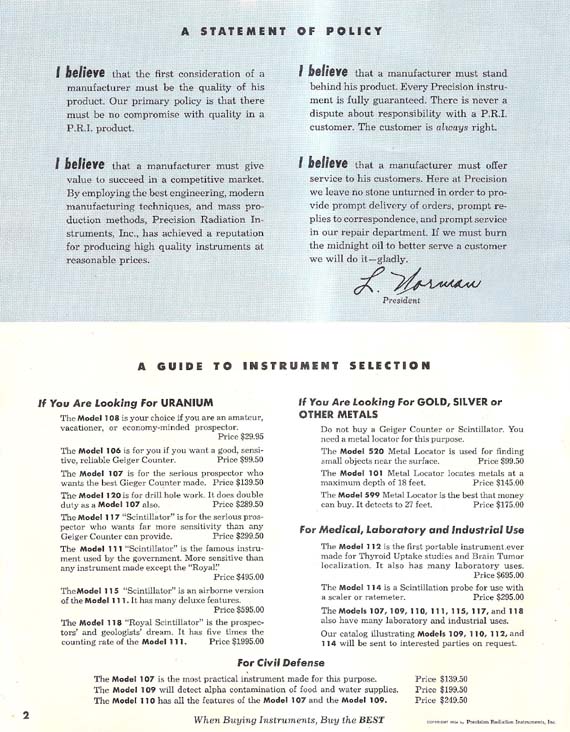
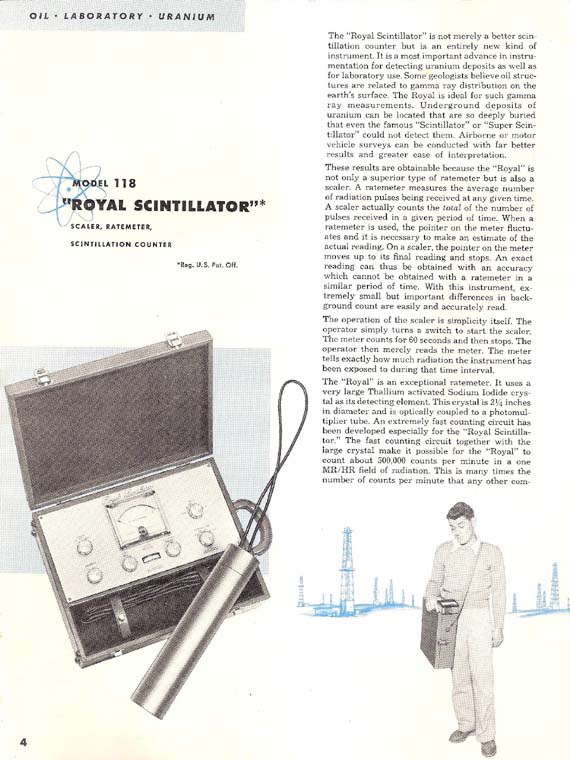

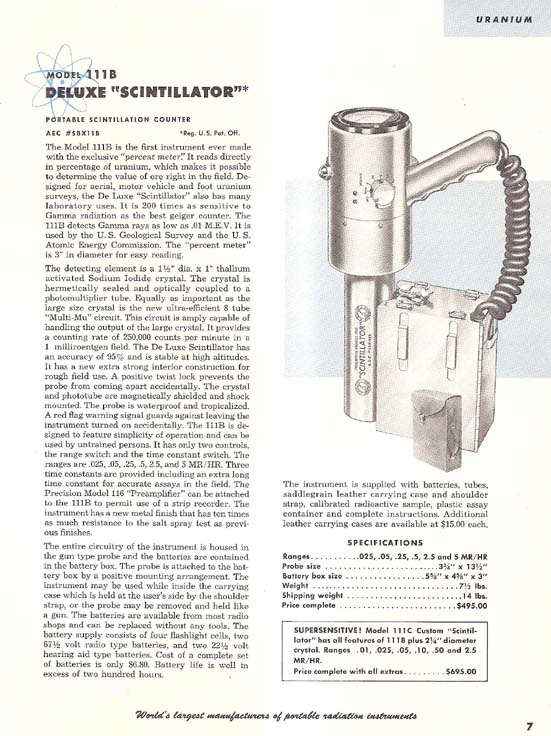
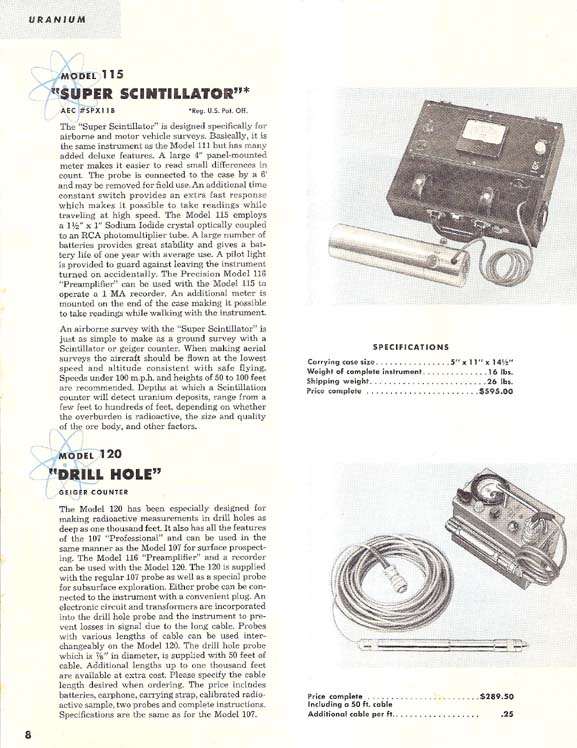
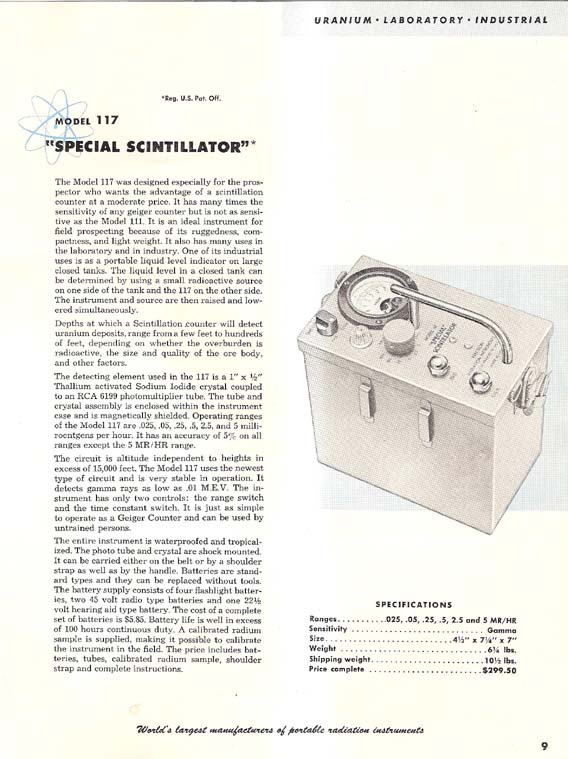
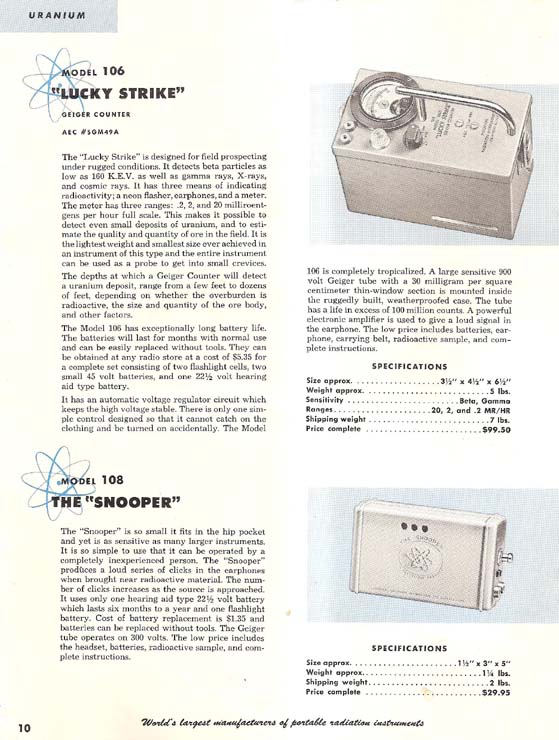
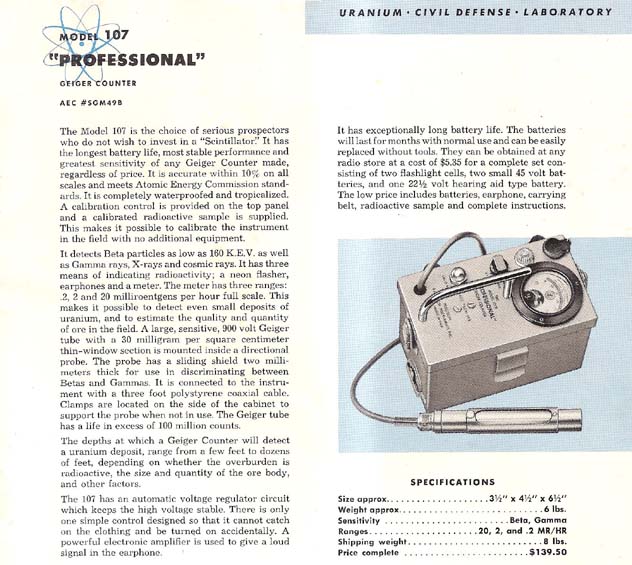
A PRI catalog from 1955 is shown to provide the variety radiation detection instruments offered during that year. They range from the small handheld units to the more expensive scintillation units.

